
Blog 52 by Tan: Beware the Singing Little Girls
After all the excitement of Danakil we were happy to chill in Mekele until we’d caught up on sleep and were ready to hit the road again. Mekele was by far the nicest looking city we had encountered thus far in Ethiopia. There is a highly reliable generalisation one can make here in Africa; when you come across a disproportionately well-developed town, you can bet your bottom dollar that it is the hometown of a president/dictator/absolute ruler wannabe. When we came into the outskirts of Mekele, a large and impressive wind turbine project came into view, then gigantic apartment complexes all very empty and very much out of place. As we rode into town it was infrastructure central with proper hotels, well maintained nature strips, stadiums, hospitals and the like lining the main road. Addis had nothing on this place. As suspected, it turned out the former leader Miles Zenawi was from the Tigray region of which Mekele is the capital.

Classic Tigrayan hairstyle
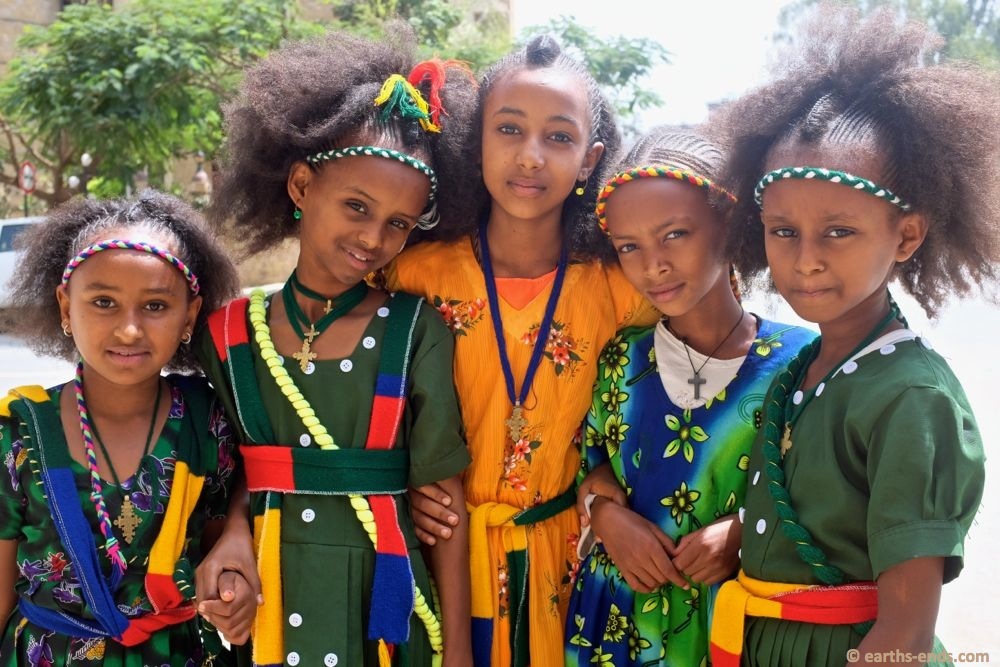
The ‘virgin festival’ in full swing
Unfortunately our extended stay in Mekele coincided with a huge government meeting that had just about every hotel in town booked solid. Finding a hotel room was a mission and took most of the day, something that is highly unusual for Africa. Our eventual hotel was new and cheap and while it had no running water (rather common for us), the staff were nice, so we were happy. It is always a gamble whether the place you’re staying is going to turn into a heaving nightclub come 10pm. We are quite used to this kind of thing and have adapted to be able to sleep through African dance music played to ear-bleed levels. However, that night the hotel/discotech’s music reached a whole ‘nother level, compromising both our sleep and the hotel’s structural integrity.
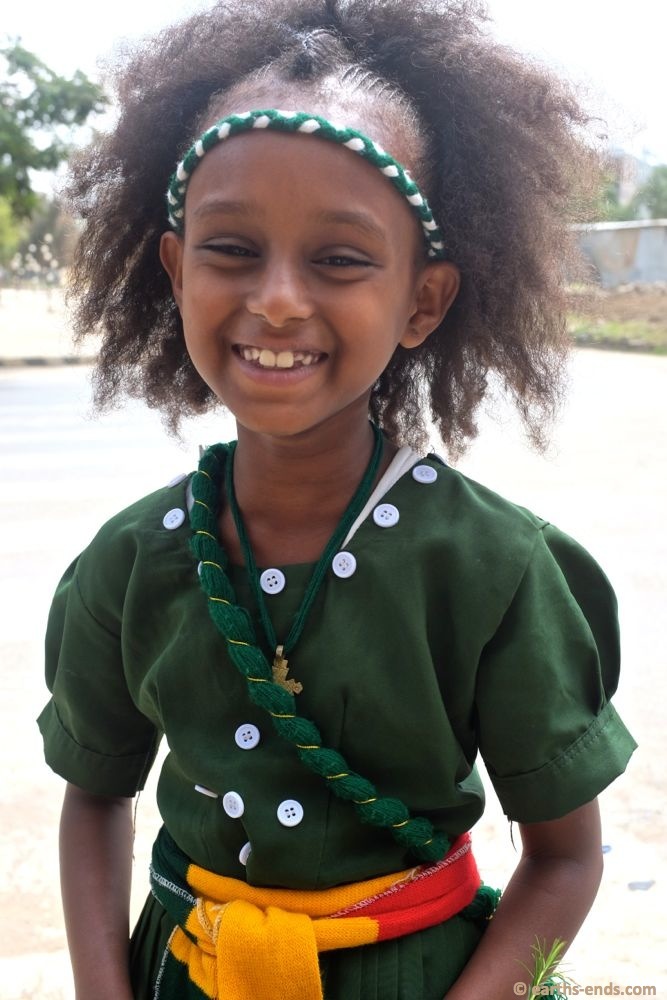
Apparently all the girls get new dresses for the event.
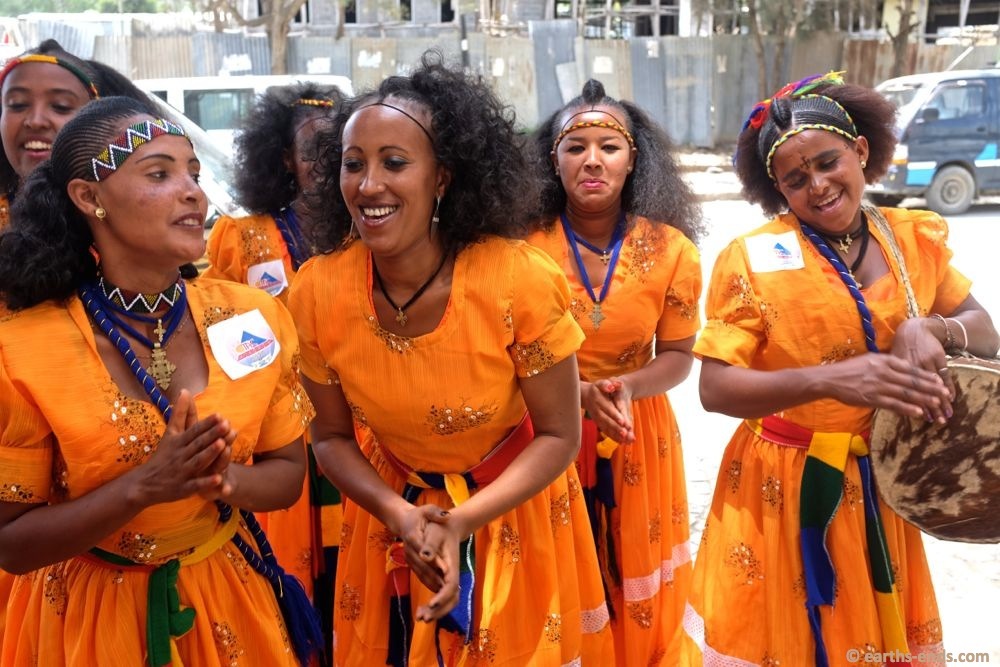
Lots of ladies co-ordinate outfits for the festival
It wasn’t just the big government shindig happening in Mekele either. We were there in the midst of the ‘virgin festival’ which from what we could gather was a popular celebration of the Ethiopian Orthodox church that is rather big in the Tigray region. It seemed a celebration that allowed the ladies their ‘time in the sun’ where they were permitted to forgo some of their disproportionally large workload, get dressed up and made up and walk through town singing and dancing with their girlfriends. All sounds rather nice but there was a distinctly Ethiopian flavour to it. Girls will go in groups and sing and dance in front of people until they pay them money. The groups of girls will then go away and solicit the next people. It was interesting to watch the varying intensity of effort put in by the different groups of girls. Some were more shy and would even walk off if no money was forthcoming and just enjoy themselves. Others were all business employing encircling tactics and various flanking maneuvers and a level of intensity the average mafia enforcer would be impressed by.
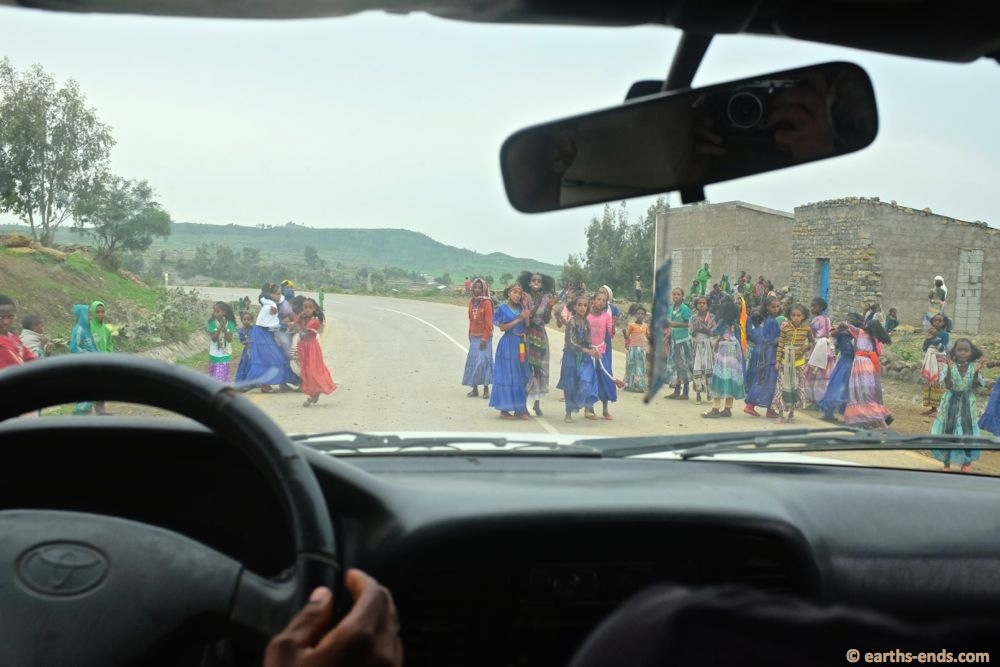
The dark side of the festival
When we left on our Danakil tour we saw that the ‘virgin festival’ was in full swing in the smaller villages too. Young girls and women were dressed up with hairstyles in traditional Tigrayan fashion, beating drums and soliciting payments just as in the city. However in the poorer villages the girls have to be a lot more… err …proactive to receive their ‘donations’ as they couldn’t take advantage of a captive audience like you can by going into cafes and restaurants in the city. In the poor villages there was also the matter of there being very little money to pass around. So outside people and money needed to be brought in.
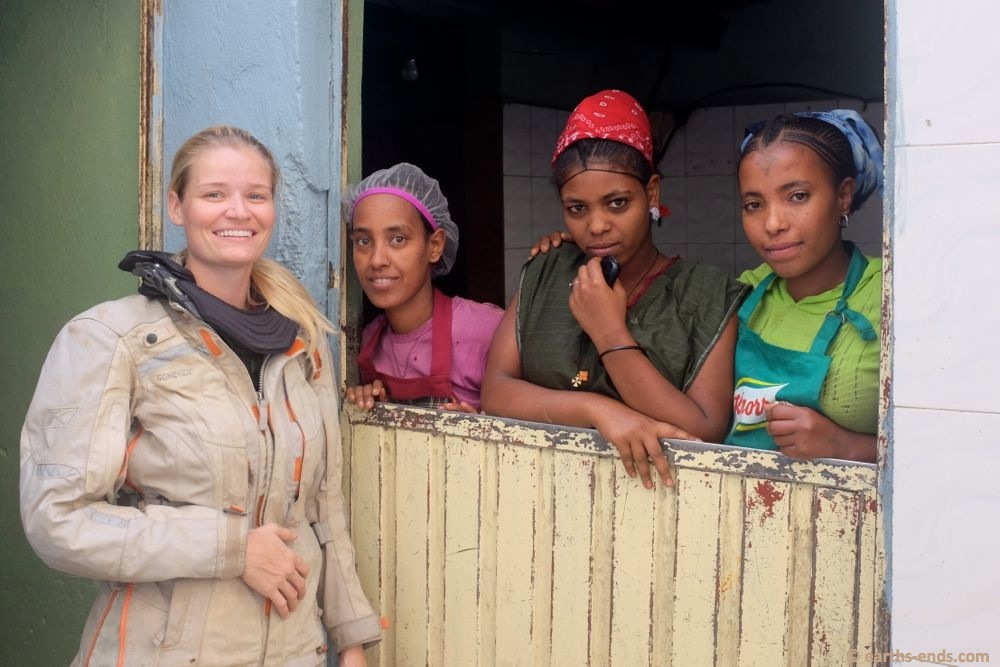
The kindly kitchen ladies of the hotel where we left our bikes during our Danakil tour
The girls in the villages would therefore assemble a large group and stand in front of cars travelling along the highway. We even saw ropes drawn across the road. Once the vehicles slowed they would sing and smile until they got money. If the cars moved off without giving money the girls would yell abuse and strike the door and windows. It could be really aggressive and was undeniably dangerous for the kids on the road. And surprise, surprise they would throw things at the cars too when they didn’t get paid. We witnessed this dark side of the festival both leaving Mekele for Danakil and upon our return in the tour car.

Crushing freshly roasted beans in preparation for a coffee ceremony
As a biker it was an absolutely horrifying sight. We knew there was no way we could face such things on the bikes. We would get torn to pieces. We resolved that there was no way we would be leaving town until this agro begging festival was finished. That’s right… us big burly adventure bikers resolved to hide in our hotel until the all the little girls went away.
Truth be told I was exhausted from all the excitement and physicality of the Danakil tour and wanted a decent amount of rest before hitting the road. Ensuring we aren’t fatigued when we hit the road is out most important safety measure on this trip. It goes double for Ethiopia where there is a considerably higher level of hazards on the road in the form of people and animals, if not vehicle traffic.

Our mates Connie and Alex that we met back in Nairobi joined us in Mekele.
After a couple days of doing nothing we started to think about moving on but lacked the motivation to follow through. This happens periodically throughout the trip and we take it as a sign our bodies must need the rest if we are shocked and repulsed at the very idea of packing our panniers. And we found Mekele to be a pretty lovely town and there was one particularly awesome pizza place that had a hold of us in our injera intolerant states. And right nearby there were fantastic juice bars and cafes so we were pretty content to be exceedingly lazy in Mekele.
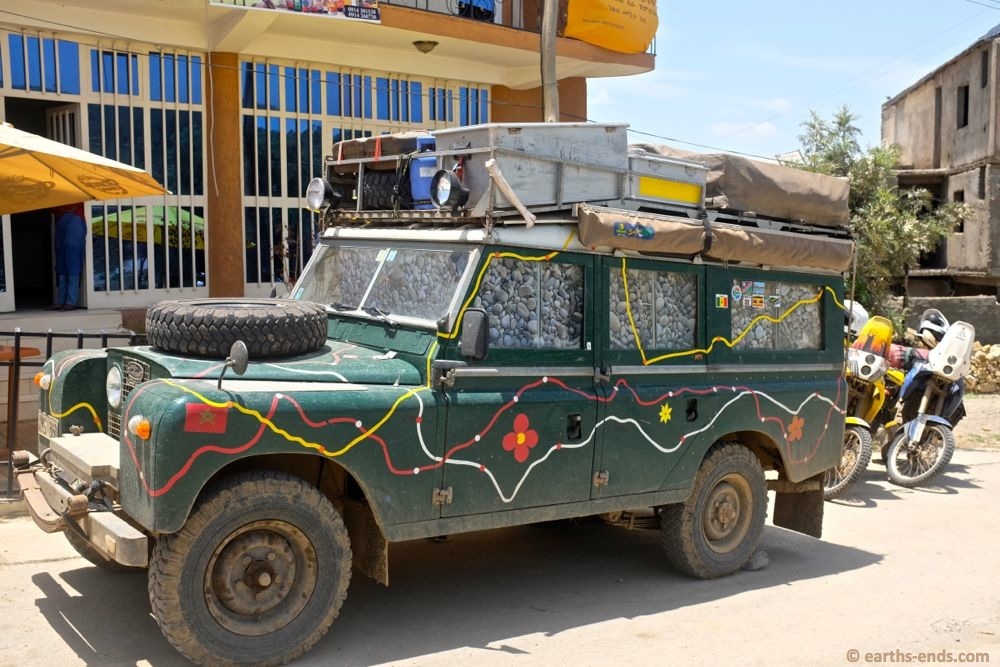
They had a most impressive early 70’s Series 2A Landrover. Alex said he could have done the trip in many different vehicles but loved the old Landrovers so wanted to do it in that. What they lacked in comfort they made up for it in Overlander cred.
Eventually it hit us that we were desperate to return to our new friends near Omorate and the only way to get there was to drag ourselves away from the macchiatos and pizza and get moving. But fate intervened as it often does when one faffs about enough to let it do so. As we went to stock up on cash we found all the ATMs in town were offline. We didn’t want to risk needing to exchange our USD stash so figured we might as well stay another night. The decision was locked in when we received word our German friends Connie and Alexander would be in town that night.
After spending the next morning with those guys we did eventually get moving on our way through the dirt roads of the Tigray regions to Axum. The region is known for its many rock hewn churches many of which are precariously located on difficult to access cliff faces. It is a fantastic part of Ethiopia to explore as it is off the main tourist trail, in a very peaceful and scenic area of the country. We had written down a bunch of churches we wanted to visit before realising, that although they are no doubt fantastic sites, we just couldn’t be bloody bothered.
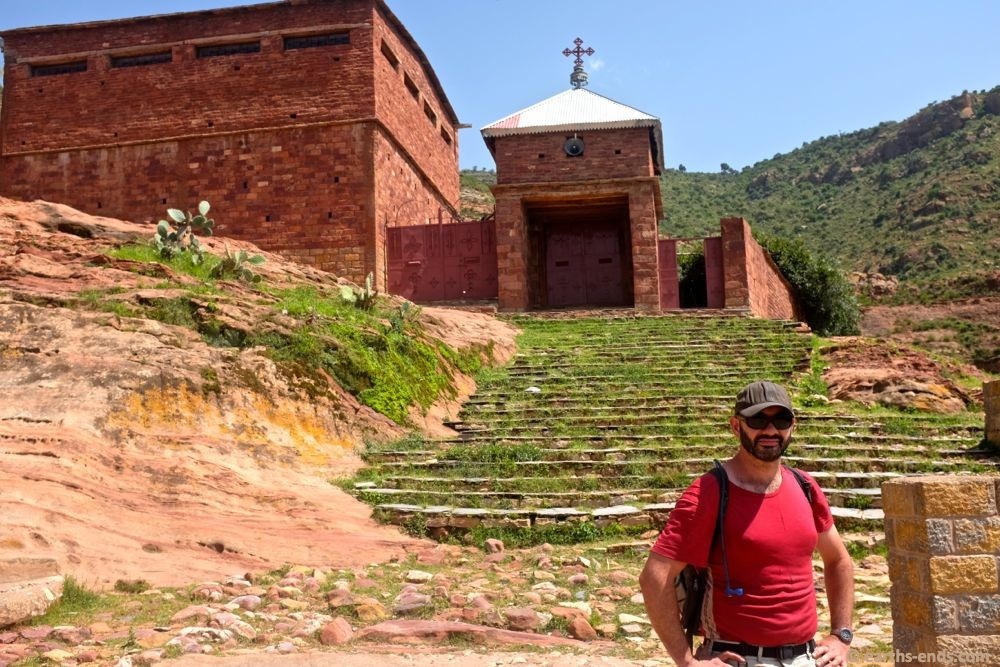
Outside Abraha We Atsbeha – one of the oldest and most well known of Tigray’s rock-hewn churches.
We were in the throws of tourism overload. The good thing about Ethiopia is that it is chock full of interesting natural and cultural sites but there is so much to do it just wore us out. It felt too busy and too over-stimulating and that is really not our gig. So we opted to see just one of the recommended churches, think not about what we missed and just enjoy the ride. Less is more. Less is always more. Overconsumption is at the heart of the current developed world experience. And just as you can overfill your house with stuff until its cluttered and unmanageable, so too can you overfill you travels with experiences. As time has gone on on this trip we have realised we want to do less and less. And rather just soak up the feel of a place.
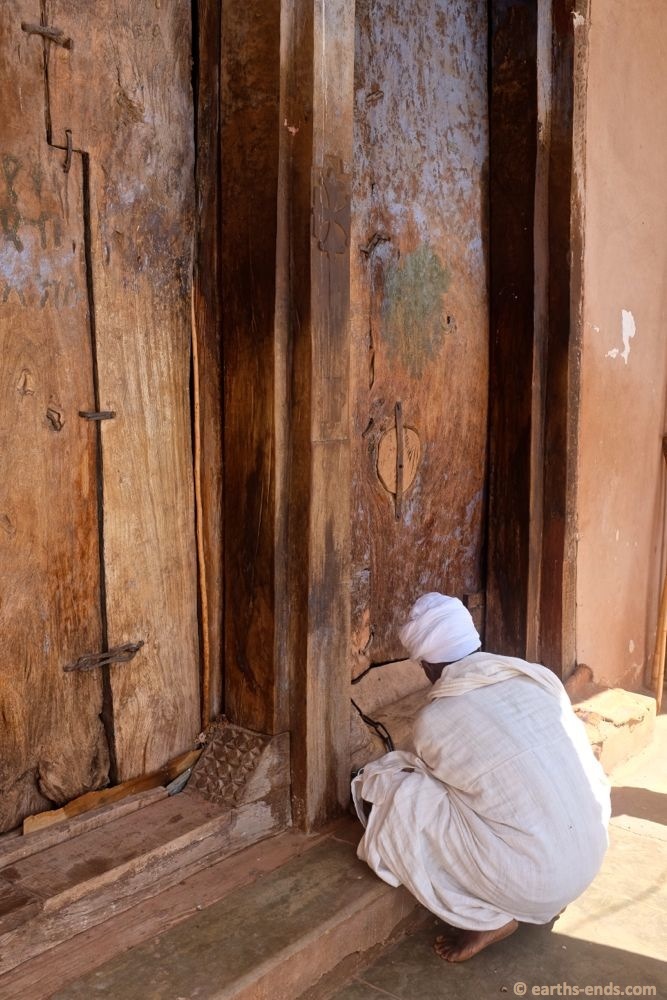
The priest opening up shop for us.
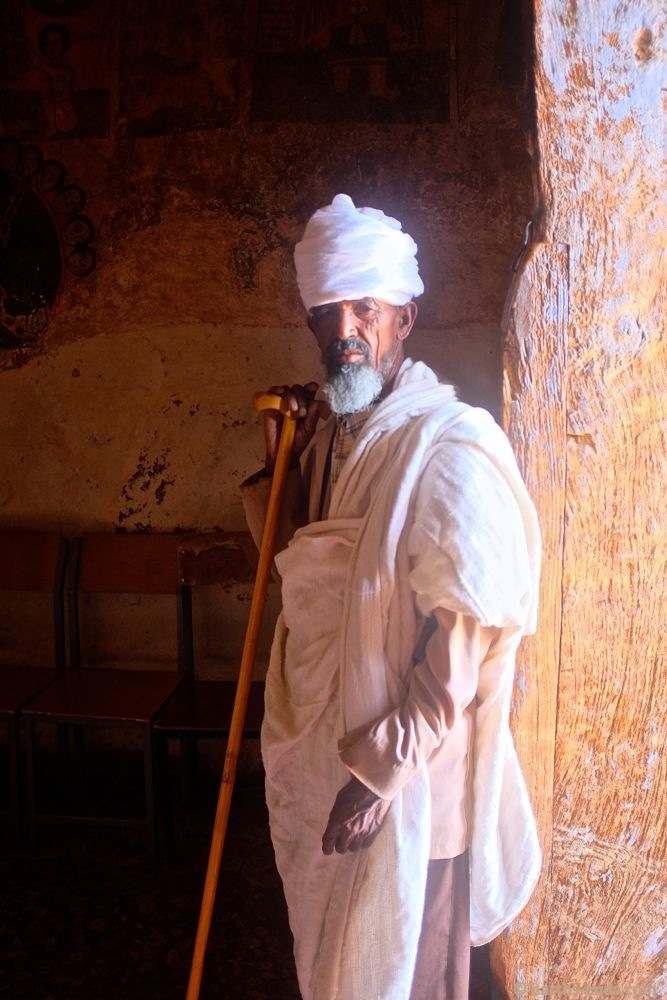
We were impressed how he managed to keep his whites white.

Impressive paintings floor to ceiling.

It is amazing how well the paintings have held up over the centuries.
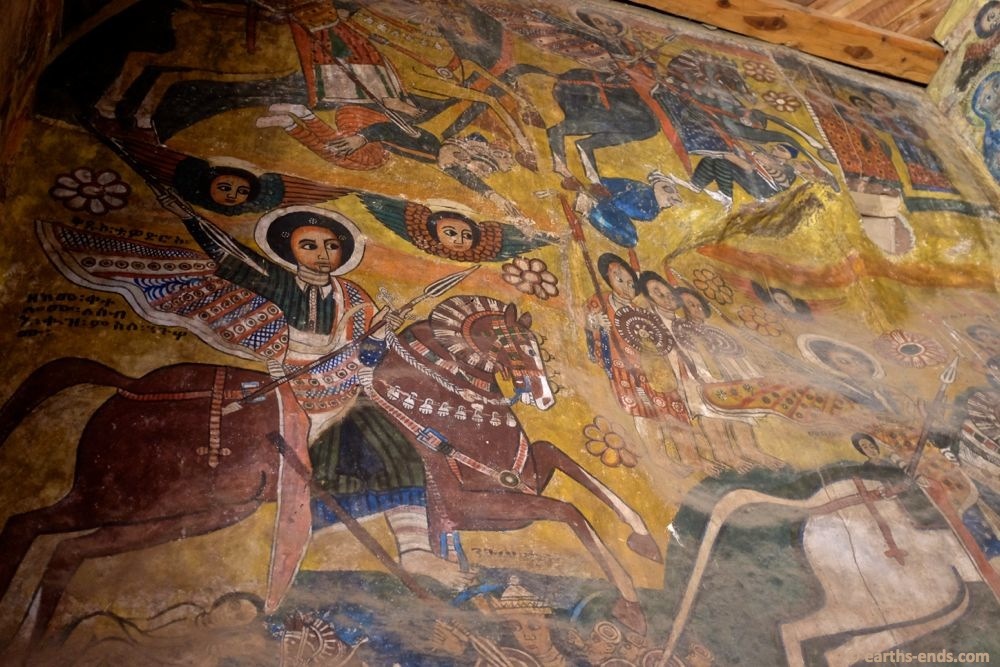
The one church we did opt to visit was the Abraha We Atsbeha church. The church is believed to have been chiseled out of the mountainside somewhere around 340AD. The church is named after the twin brothers and co-rulers, King Abraha and King Atsbeha whose mummified bodies are apparently interred there. Its reported that the last priest who tried to get to the bottom of the rumour had his hands badly burnt by supernatural fire when he tried to have a sneak peak into the coffin. As for ourselves we were content to believe the talks and avoid supernatural fire by just taking in the paintings, which are known to be some of the best in the area. We parked up and found the church custodian who went and opened up the church for us. What a sight to behold it was. Vibrant paintings depicting biblical events covered all the walls and ceiling. The priest went to pains to point out the various saints and events before us. There were so rather macabre scenes intricately depicted reminding us biblical times were ….a bit rough to say the least.
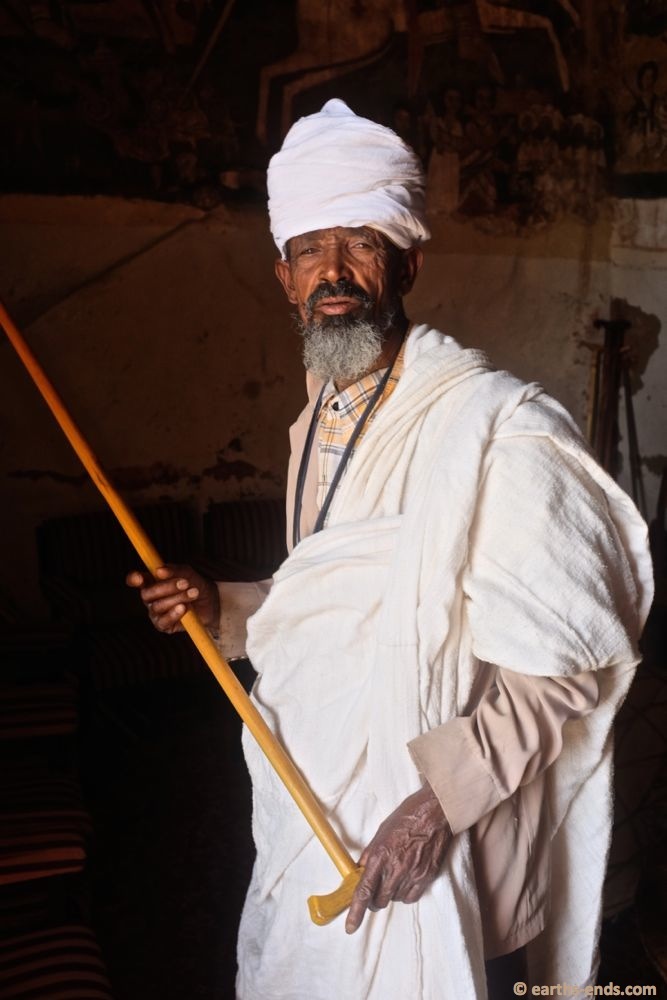
The priest pointing out the various saints and religious figures we were racking our brains to recall the stories behind.
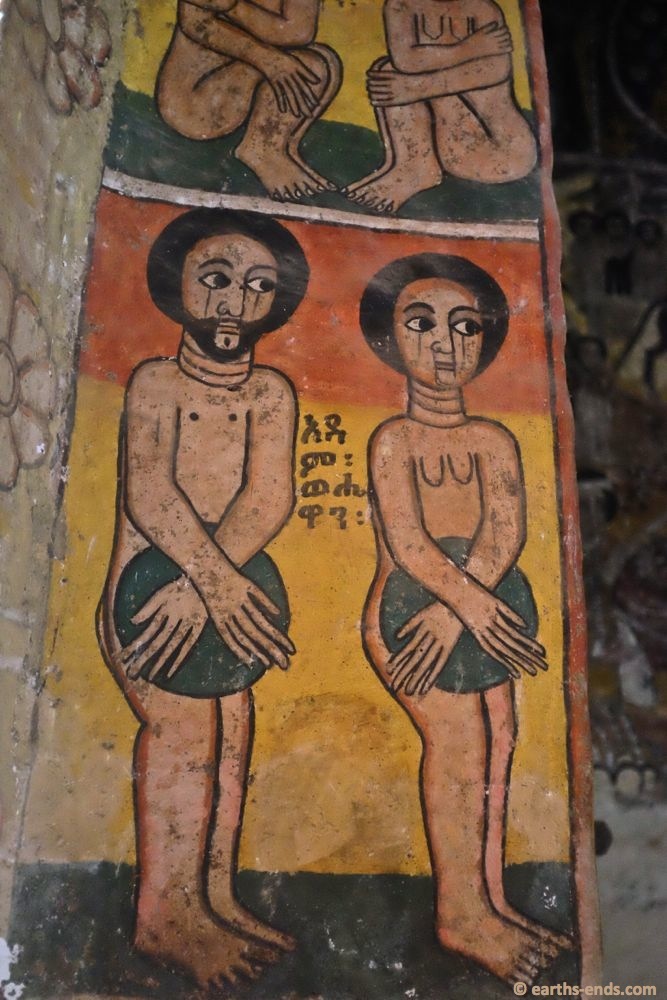
These guys we knew. They have just become aware of their nakedness.
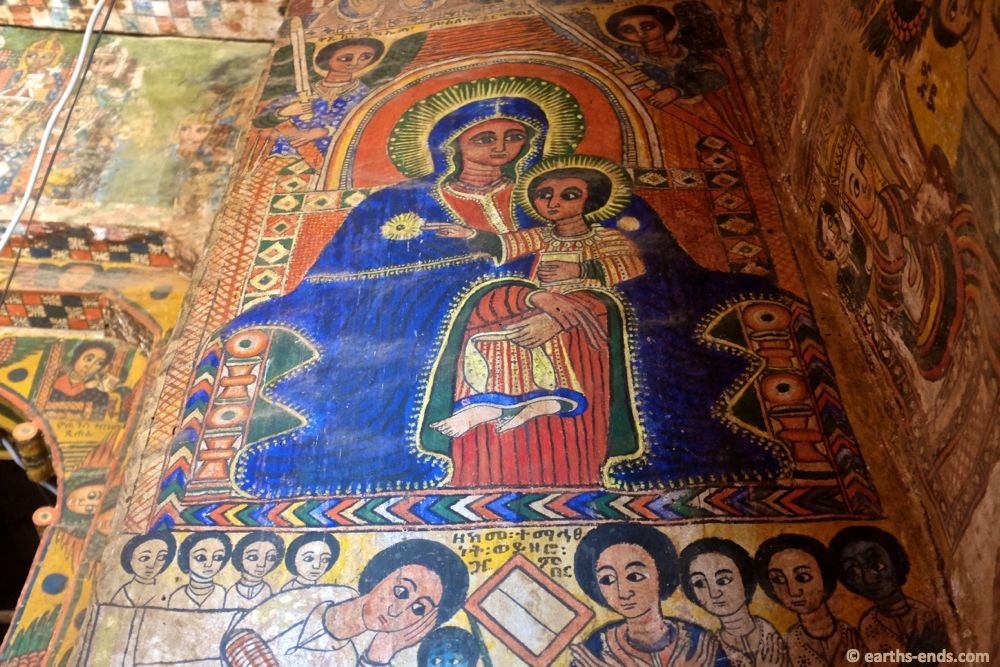
Mary and Jesus – quite different to the usual depictions of the two but instantly recognisable.
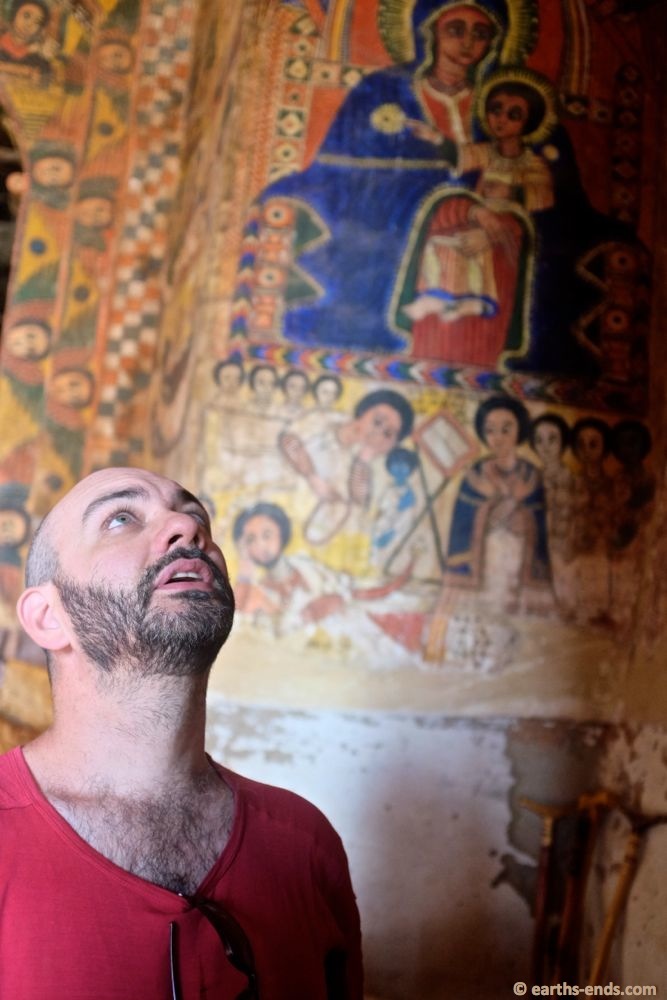
Michael taking it all in.
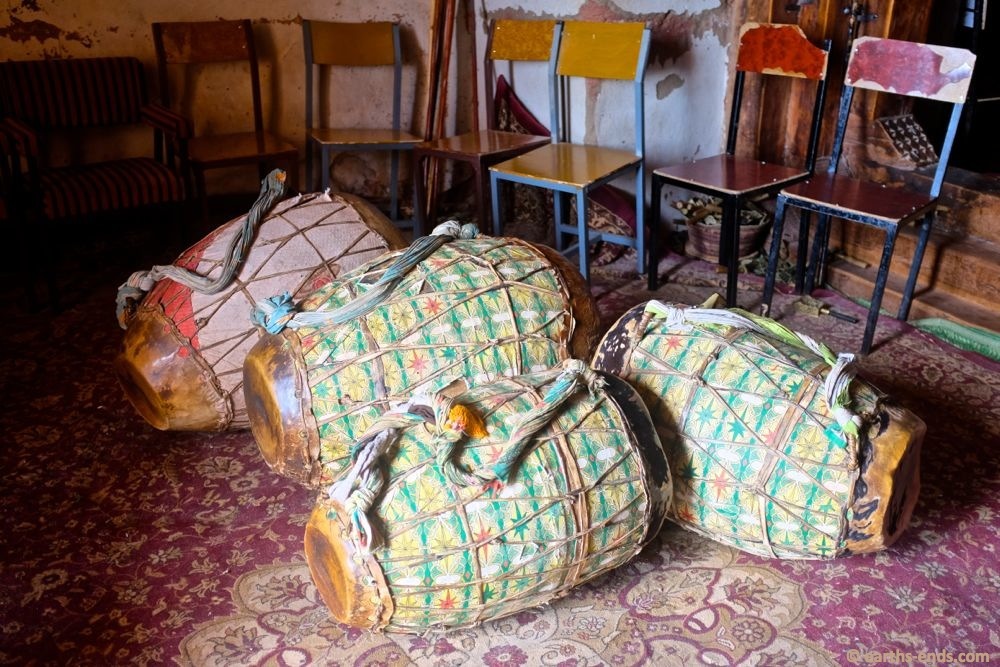
Drums in the chanting room of the church.
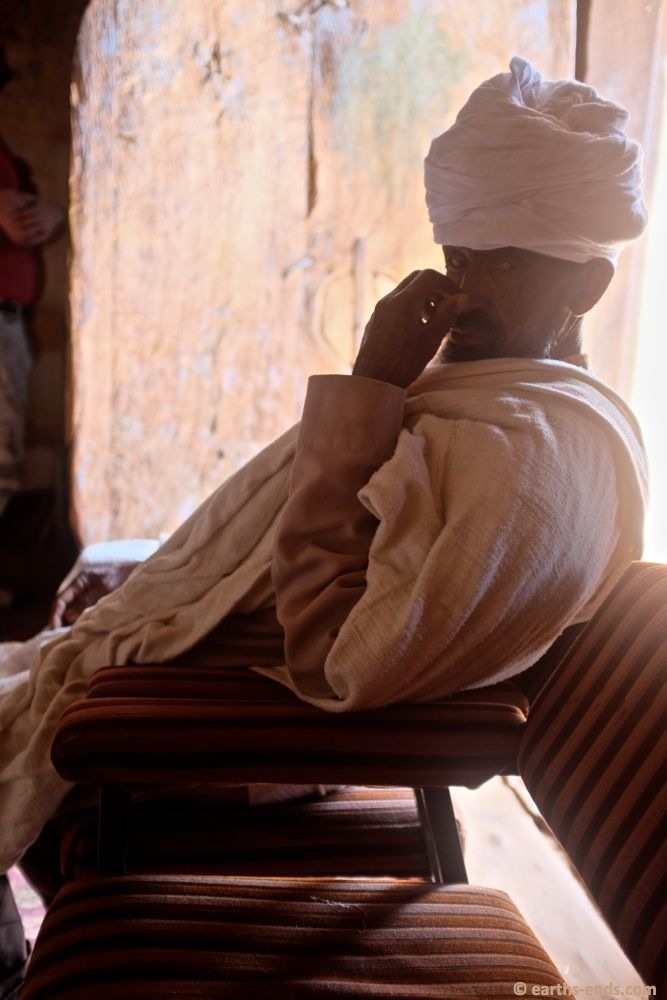
The priest chilling.
After getting our fill at this very worthwhile stop we hit the road once more on our way to Axum. The winding dirt roads surrounded by awesome views made for a most excellent afternoon of riding. The scenery was slightly reminiscent of parts of southern China with beautiful karst rock formations along the route. The population density in this part of Ethiopia is considerably lower than most other parts and it made for easy peaceful riding with no traffic and little in the way of animals hogging the road. To me it was a stand out part of Ethiopia made for tourists. I’ve since read it is a great place for ecotourism and there are a number of outfits offering multi-day or even multi-week long hikes and homestays.

A fantastic part of Ethiopia
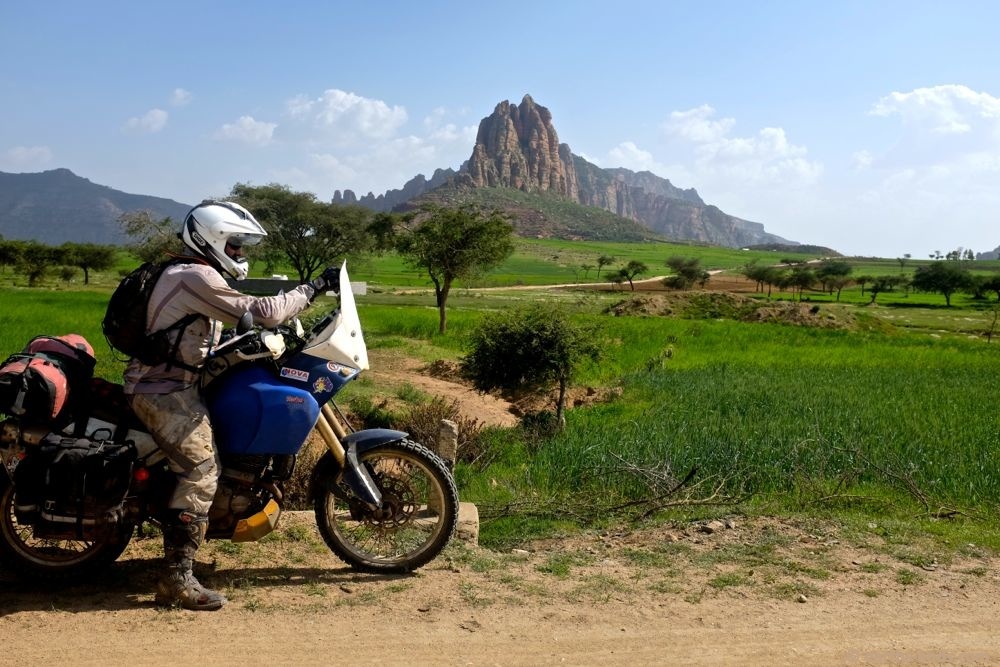
There are dozens of little rock-hewn churches all over the place here. But we opted to power on for Axum.
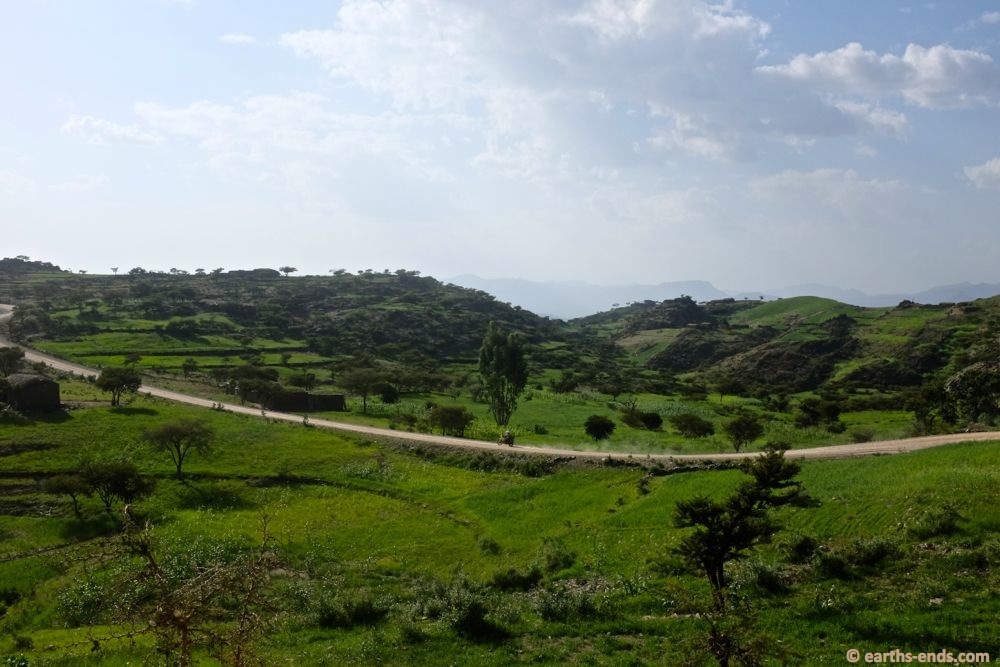
It seemed like we had the place all to ourselves.
As the day went on and we got closer to joining the main highway to Axum we came across a marauding pack of little girls blocking the entire road ahead. There was no getting past them. It was our worse fears about the ‘virgin festival’ about to be realised. We tried to not stop as they sang and crowded around the bikes insisting on payment. We kept the bikes moving and pushed forward through the throng, it was far too inconvenient to take off gloves and track down money for them all to fight over. In retrospect I don’t know if getting the cash out would have made things better or worse. We continued to inch through them but they were grabbing us and pushing up against the bikes. There were about 25 in total and these tiny little girls were inexplicably gaining the upper hand.
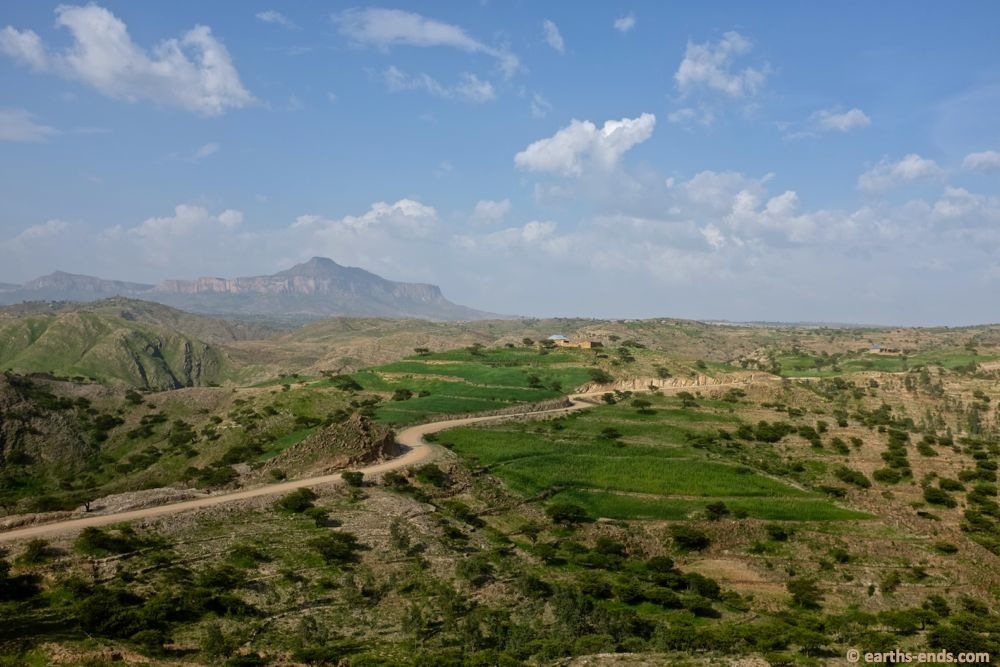
More of the same.
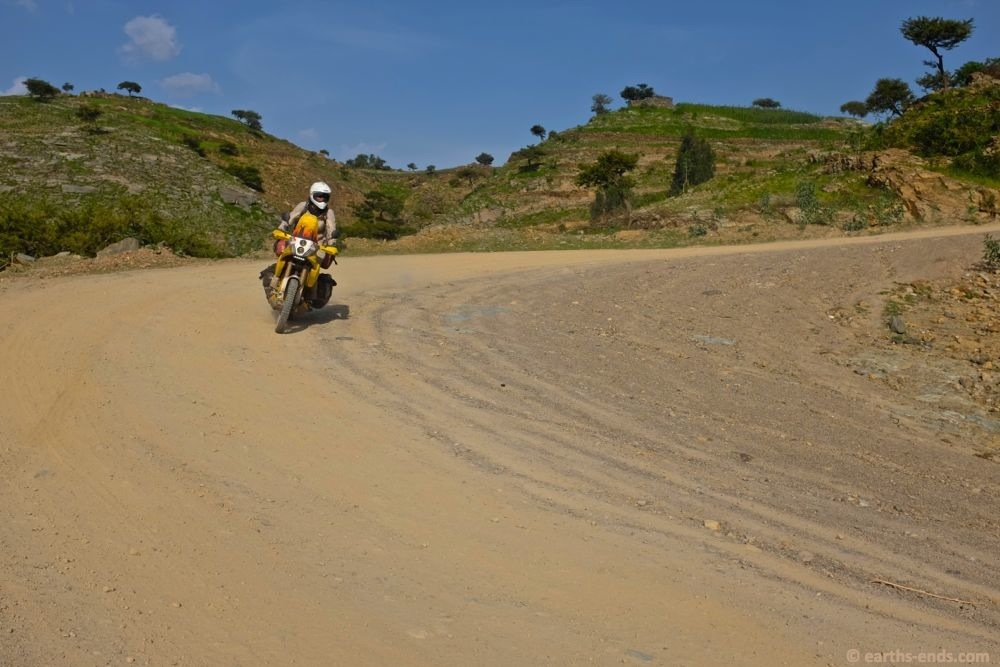
Very good quality dirt
About 6 were pushing at the front of my bike while a few other girls were tugging at my sleeve and arm. As my bike is a bit tall and top heavy with the huge safari tank I was staring down the face of being knocked over by a pack of pretty 8 year olds. Oh the indignity. We got on the horns and revved the engines to minimal effect. Mick made a break for it, which made some of the girls scatter allowing me some space to followed suit. However, a couple of girls had grabbed on to my elbow and wouldn’t release. As I accelerated off they held their ground enough to jerk my still healing rotator cuff. It hurt for days afterwards. Seriously, what kind of religious festival is this!

So you could gun it and enjoy.

Not far from Axum.
Before we knew it we were in Axum and quickly found an affordable and secure hotel for the night. Axum is a placed steeped in history. It is one of the oldest continuously inhabited cities in all of Africa and was the capital of the once great Axumite Empire that grew rich from dominating commerce through the Red Sea and Indian ocean ports. The Queen of Sheba is said to have called the place home and the Arc of the Covenant is believed (by some anyway) to be stored in a rather unassuming looking chapel in Ethiopia’s holiest shrine, the St Mary of Zion church.

Little girls out enjoying the festival
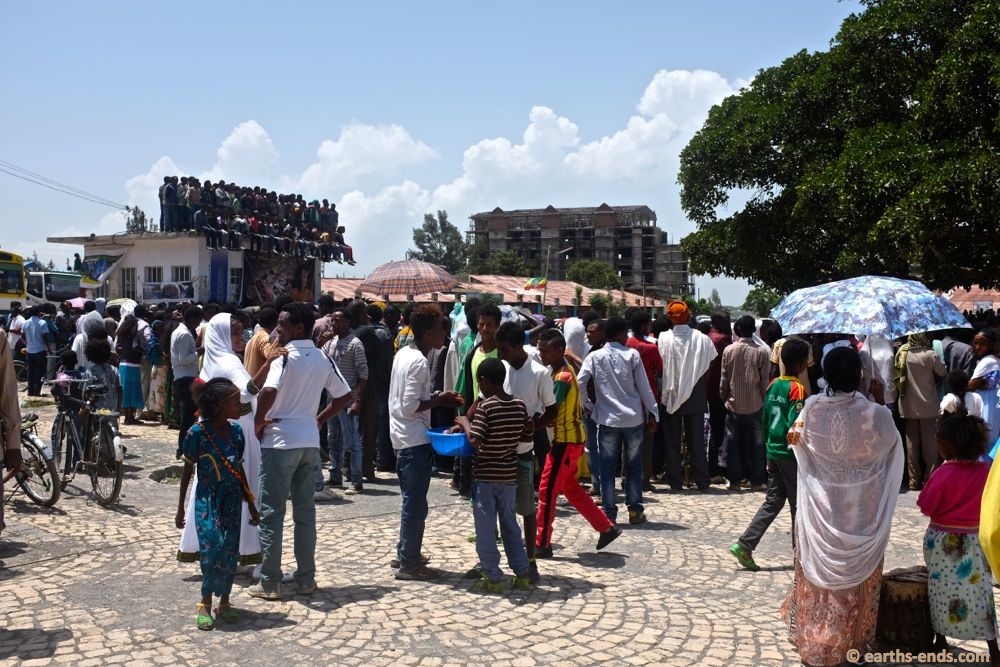
Crowds out watching the dancing.
The tales say that the Arc of the Covenant found its way here thanks to the sticky fingers of Menelik, the supposed son of the resident spunk rat, the Queen of Sheba and foreign love rat, Solomon. The story goes that Solomon was so taken by the beauty of the Queen of Sheba that he devised a sneaky plan to get her in the sack. When she visited his court in Jerusalem he had her agree not to touch a single thing in his palace. She agreed, probably putting the request down to a ‘crazy rich guy thing’. That night Solomon put on an elaborate meal of spicy and salty food. In the night the Queen of Sheba woke thirsty and tracked down some water. Solomon was waiting and informed her she had broken her vow. And somehow that translated into obliging him with a night of whoopee in recompense. Allrighty-then.
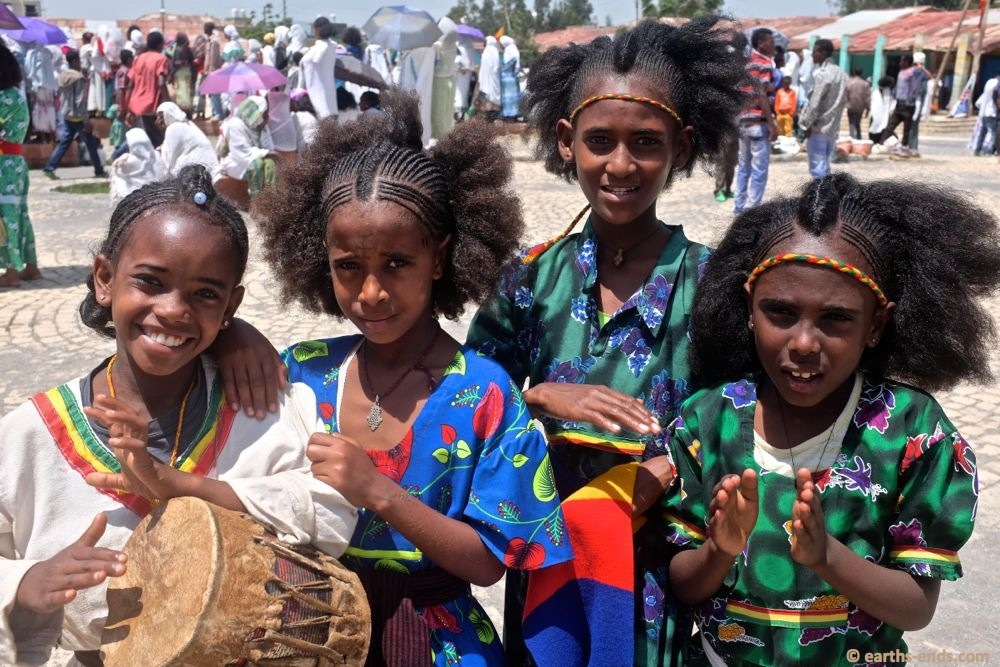
Streets scenes
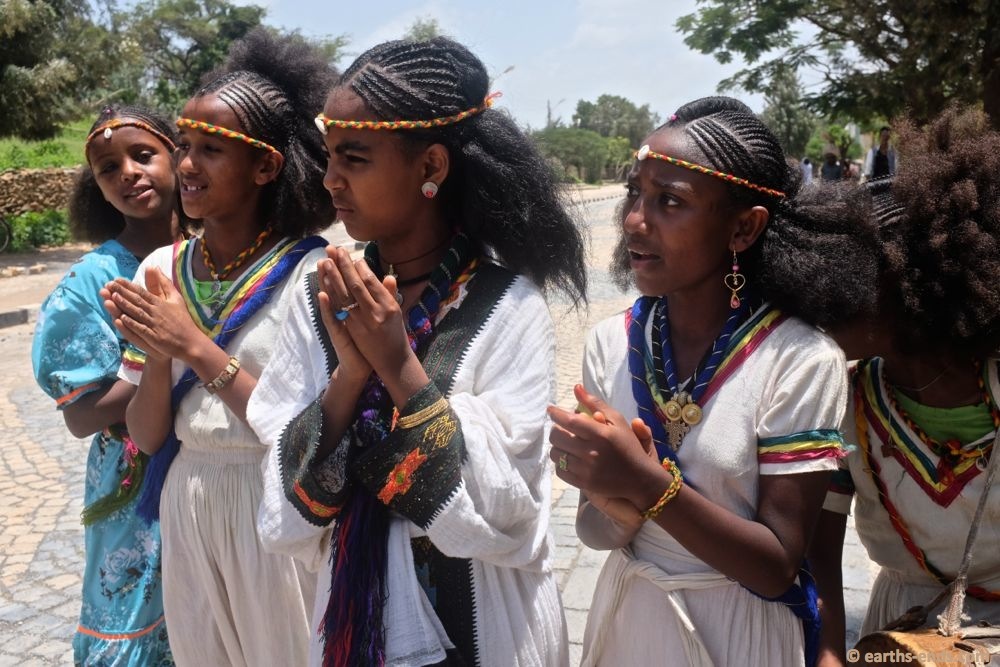
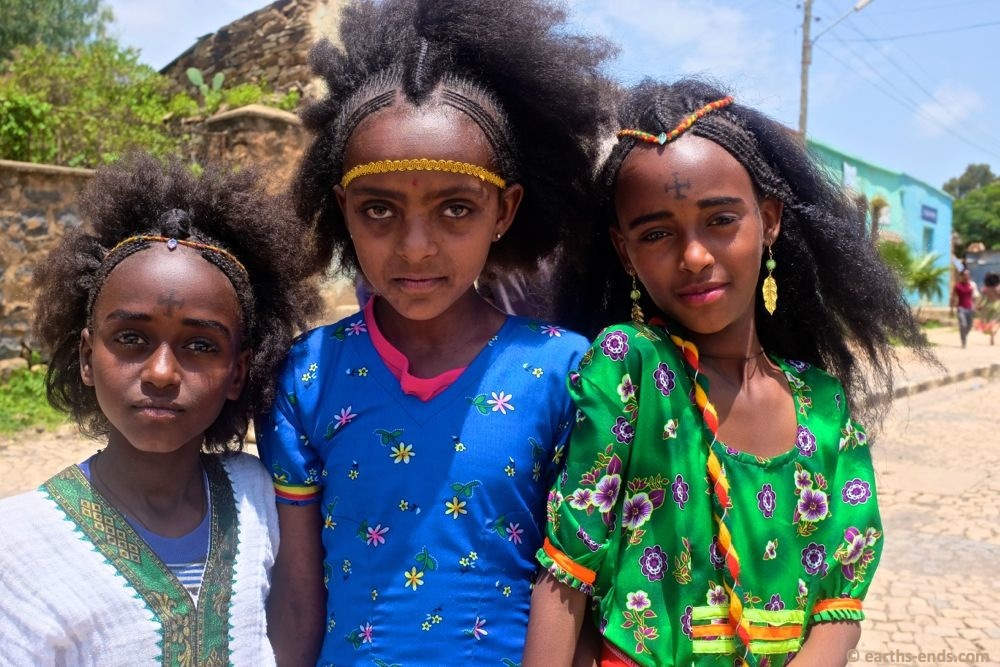
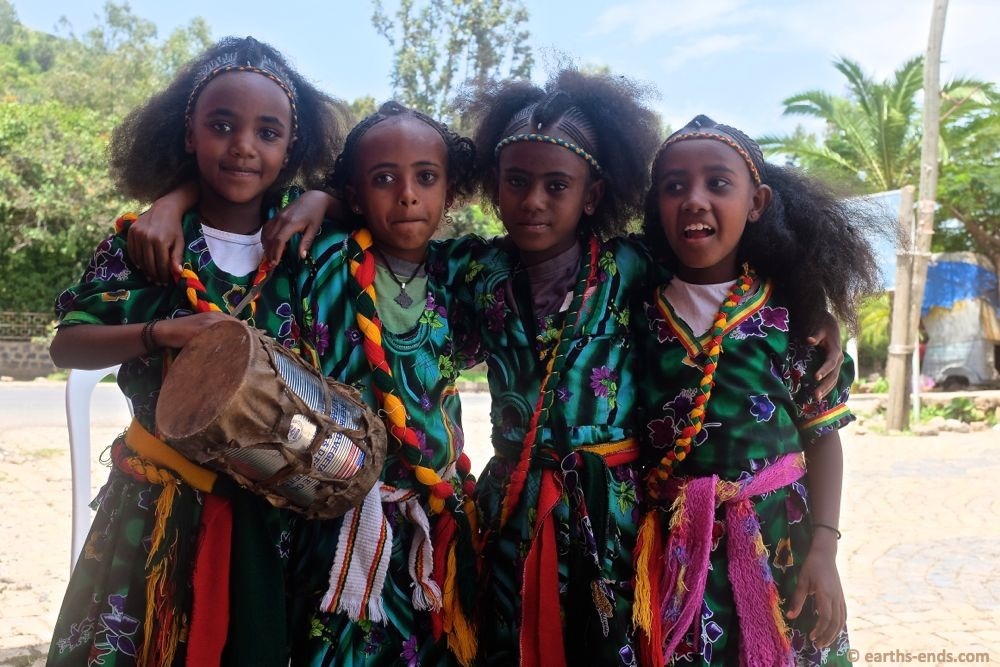
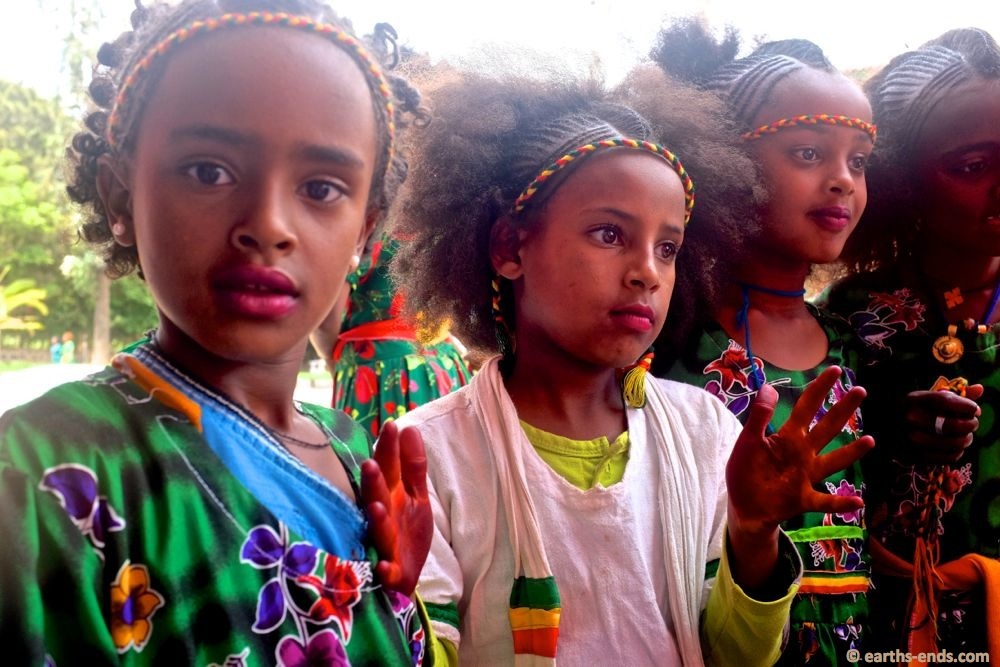
Axum remains the spiritual heart of Ethiopia. As it is a deeply religious city it was perhaps no wonder that the virgin festival was still in full swing when we visited despite it having come to a close in Mekele. The great thing about the virgin festival in Axum is that there was a much more celebratory and religious feel to the festival rather than the mercantile, aggressive cash grab nature of what we had seen in other places. The mood was buoyant and it was really lovely to see groups of women and girls swaning about town feeling like the stars of the show and having a good time.
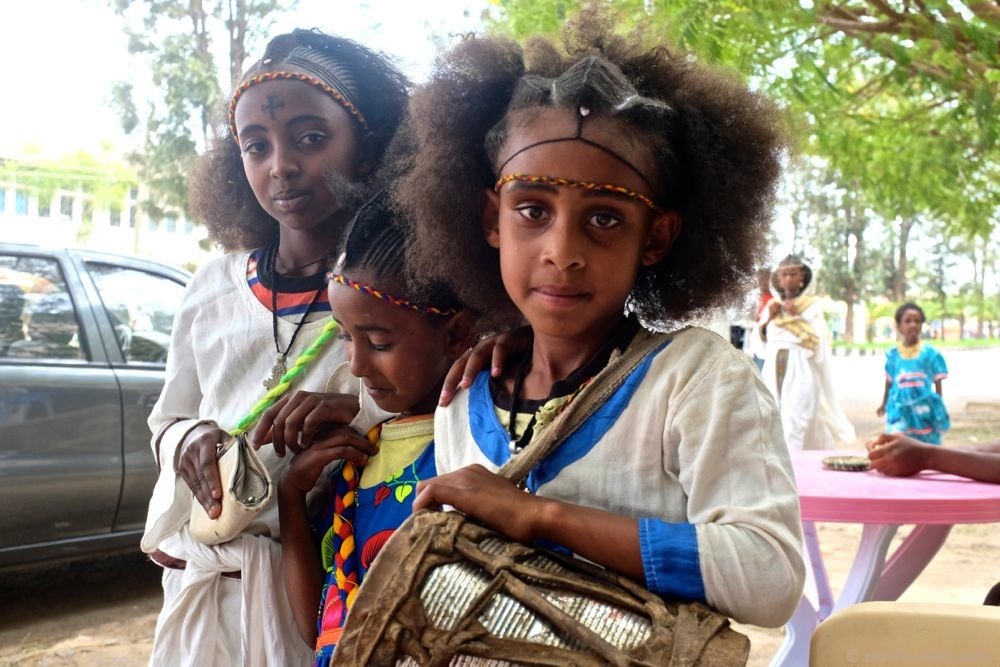
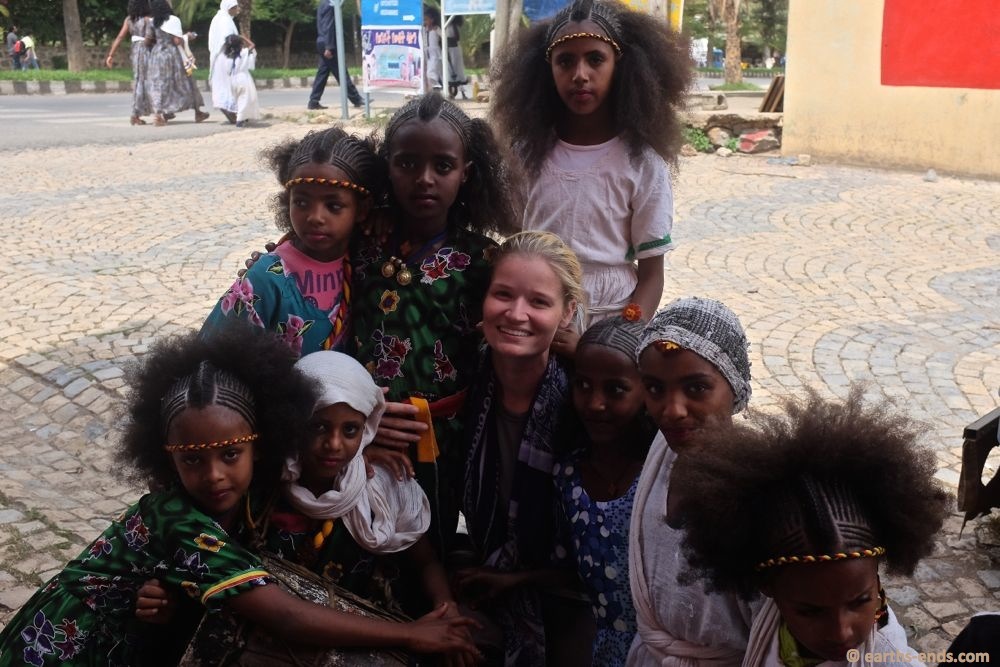
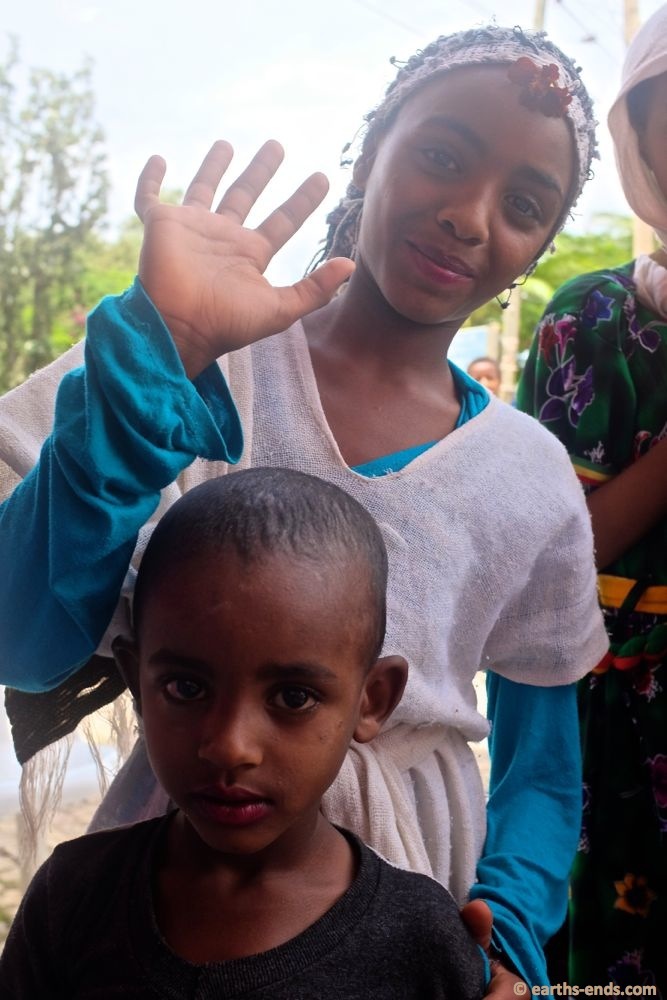
Is this girl not the spitting image of Beyoncé?
We spent the following day touristing and drinking coffee and juice while taking in the festivities. We visited Axum’s famous stelae fields where the granite obelisks range from 1m to 33m in length/height depending on whether they’ve managed to stay upright or not. It was while we were here that we got adopted by a group of four little girls. They were having a great time swaning around town and singing. They used the money they had collected (including from us) to get a local photographer to take and print a photo of them in the stelae field. These girls took a shine to us and proceeded to follow us around.
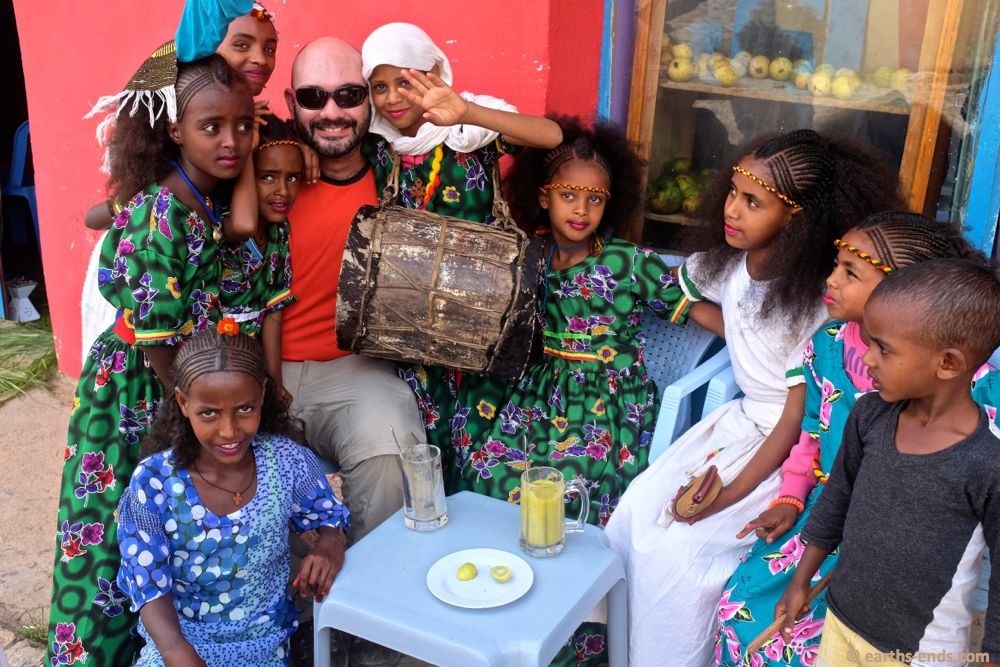
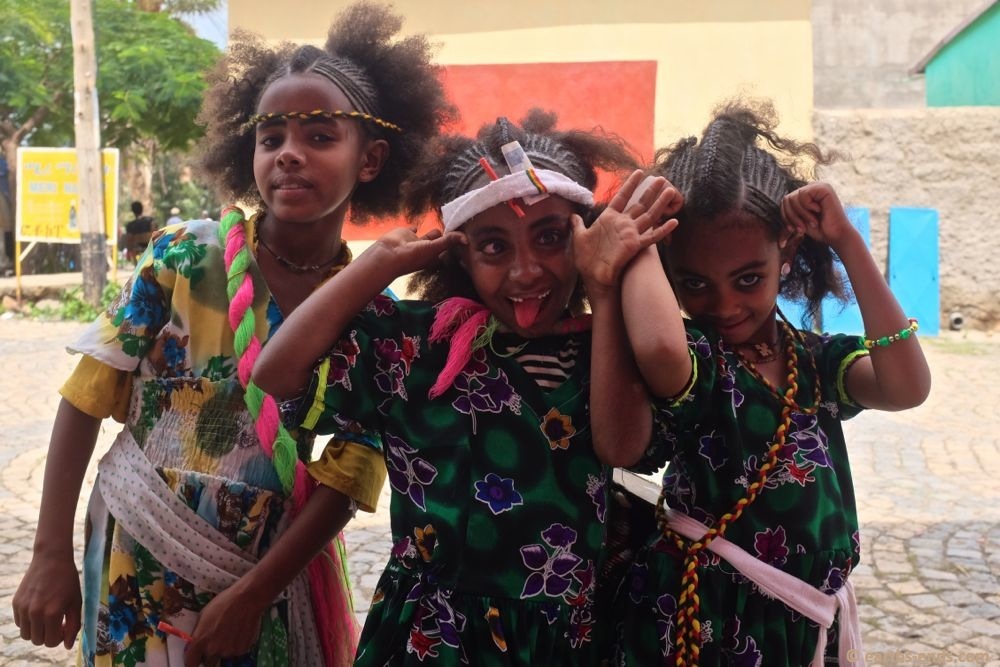
After we managed to lose them for a short time, I was sneaking a little look at a church when I felt a little kiss on my cheek from one of the girls who had appeared out of nowhere. They were super sweet and even managed to breach Mick’s tough man exterior. Eventually we had walked a long way from where we first met and had to explain to them that we had to go and that they had to stay. It was all a bit sad as they were adorable.
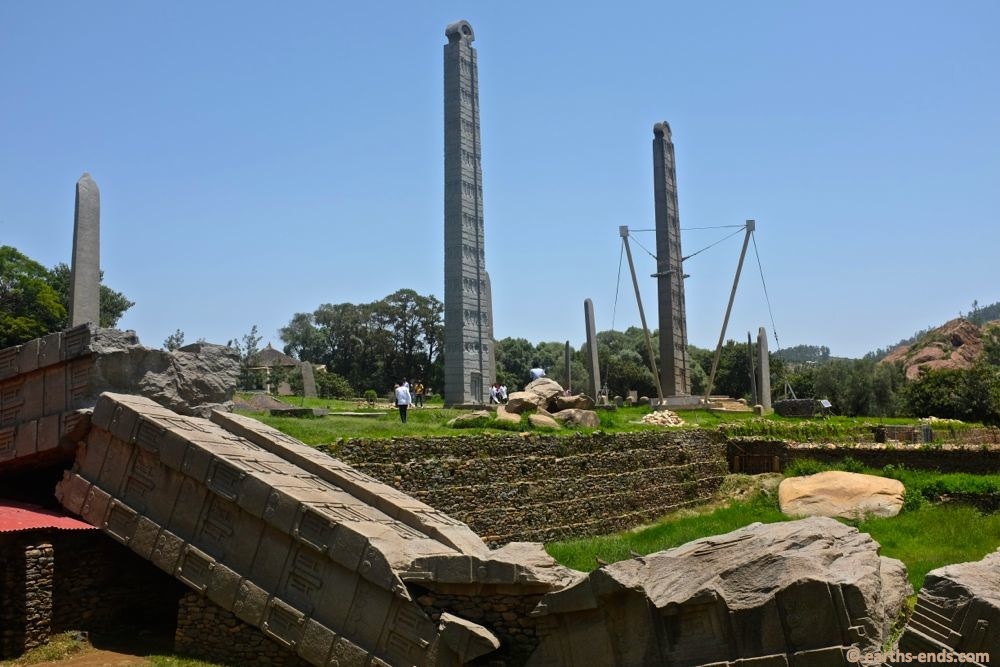
Axum’s stelae field.
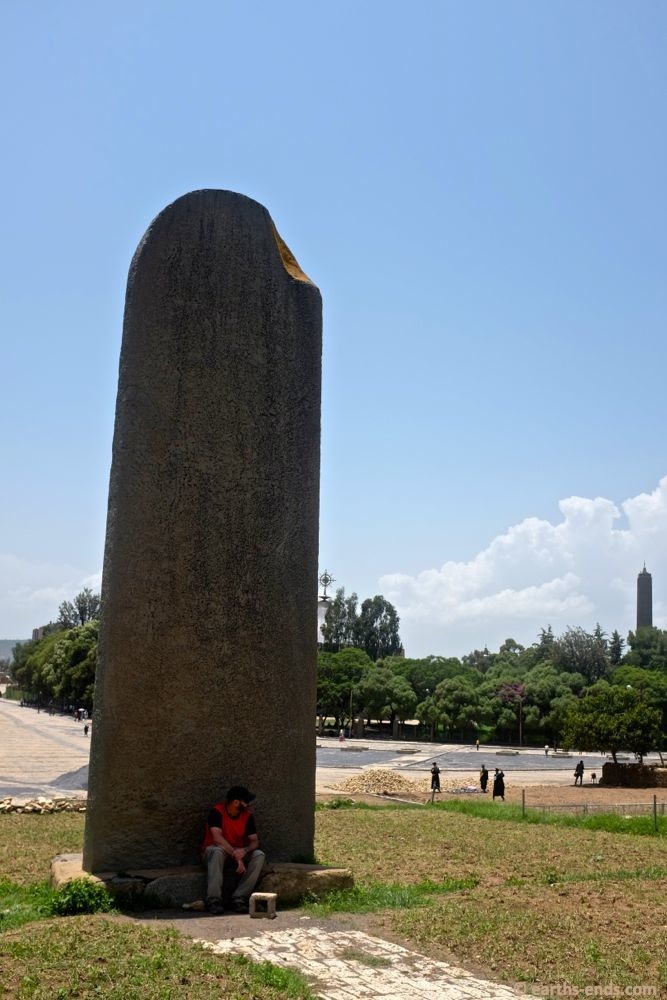
Getting some shade.

33 The sweet girls who adopted us.
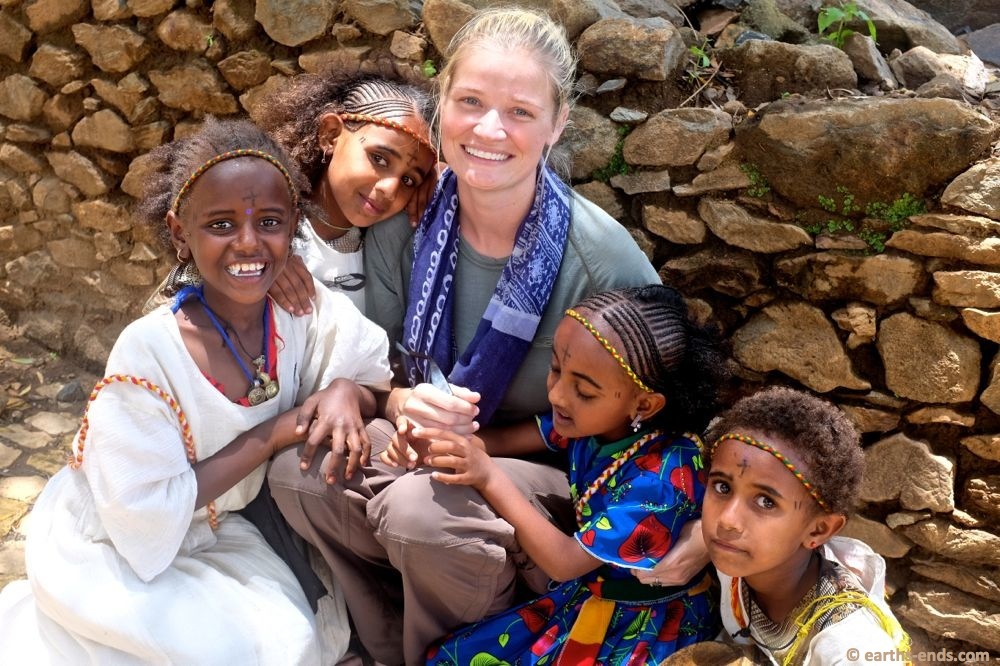

Mick showing his sensitive side.
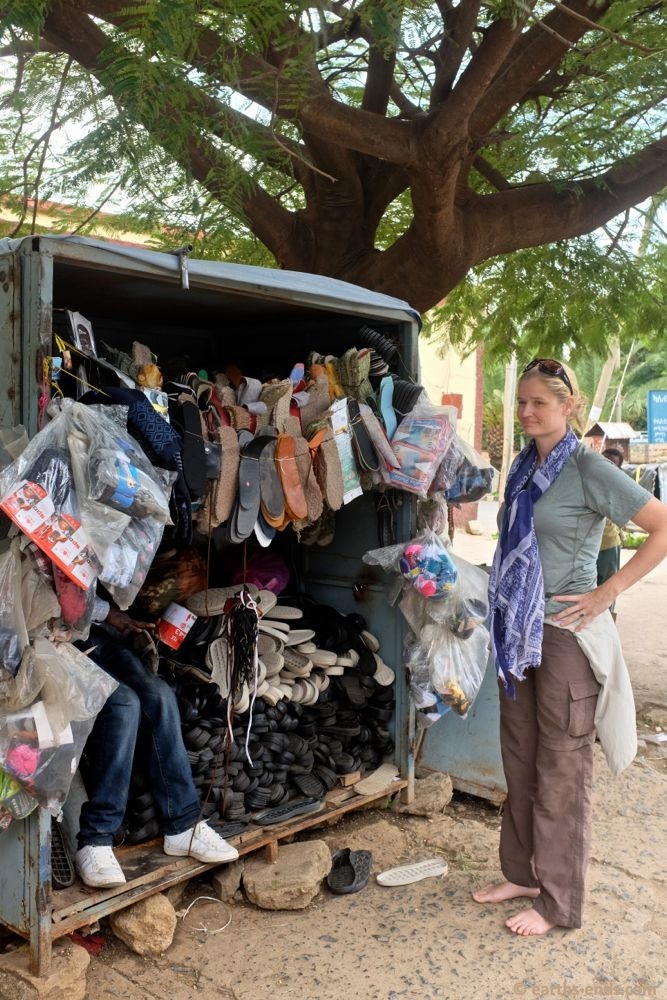
A spot of house keeping – street corner sandal repair.
Axum was a nice and chilled place and we could have easily spent more lazy days strolling and drinking coffee there but we both realised we were dying to return to our fantastic new friends Dick and Donna down in the Omo. We missed both their company and the environment of the Omo and were hoping that as old Ethiopia hands they would be able to shed some light on what we had experienced in our travels in Ethiopia. Things had happened that had left us feeling utterly despised and by a number of people we had come across. It was a new and really unsettling feeling to see people that seem to look at you with distain and to seem to want to see you come to physical harm. We were hoping Dick and Donna could shed some light on things and perhaps identify a cultural quirk or misinterpretation of things on our part. We resolved to put the hammer down and make it to Omo as soon as we could.
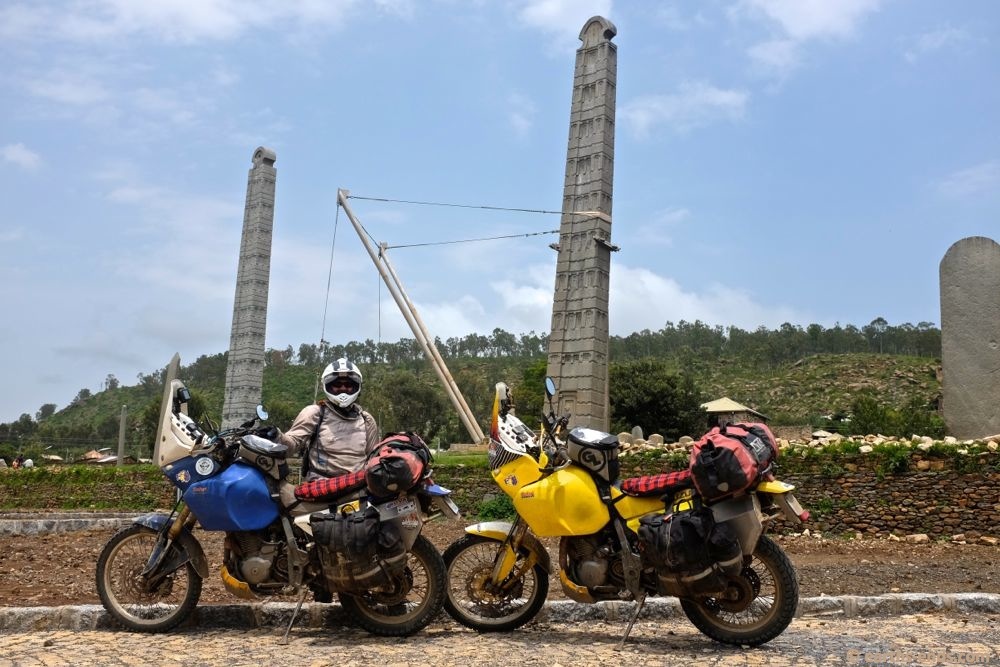
One last look at the stelae field before hitting the road.
The following day we hit the road and were greeting with fabulous smooth tar and traffic free roads. The mountainous terrain meant there was little in the way of people and animals, which made for smooth and carefree riding. It was a fun morning of mountain views and hairpins along smooth as velvet tar.

That view.

Bluey looking dapper.
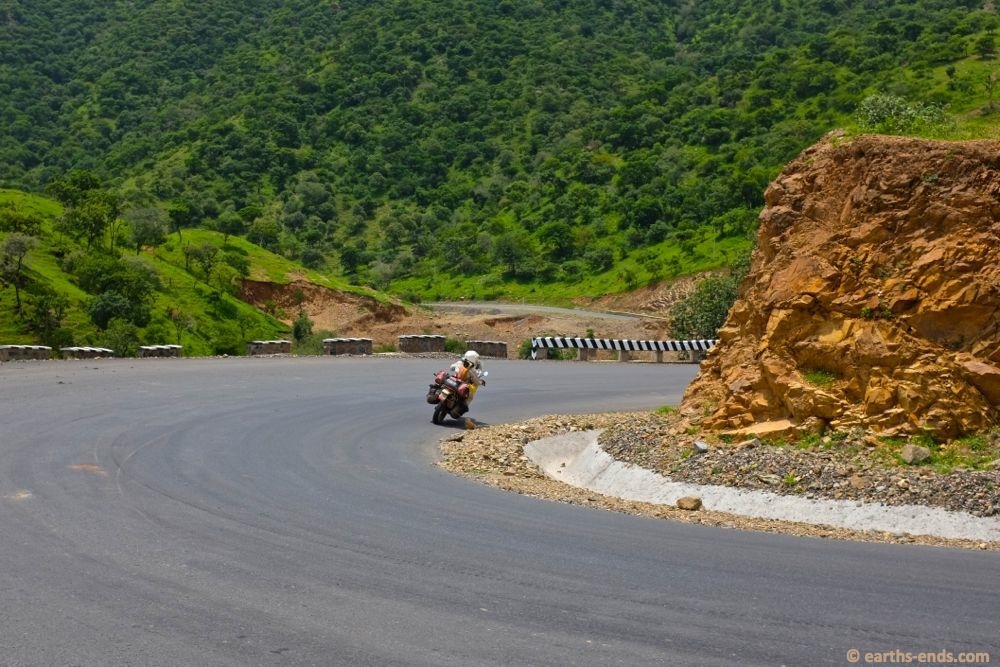
Easy easy riding.
It is at this point I must recount one of the most unusual and surreal experiences of my whole life! I was riding out in front this time enjoying the empty, smooth winding road. We saw barely another vehicle and were both having a good time on the twisties. We came down into a valley and saw a large bridge across a river. We slowed down as the road changed to good gravel as we neared the bridge. On the approach to the bridge there was a very poor looking makeshift village so we slowed down further. For a change the hazards of going through such a village were minor as the huts are constructed lower than the road so there were no kids playing or animals congregating at the side of the road. We were going about 50kph and in retrospect I wish we were travelling a bit slower but it seemed a responsible enough speed at the time.
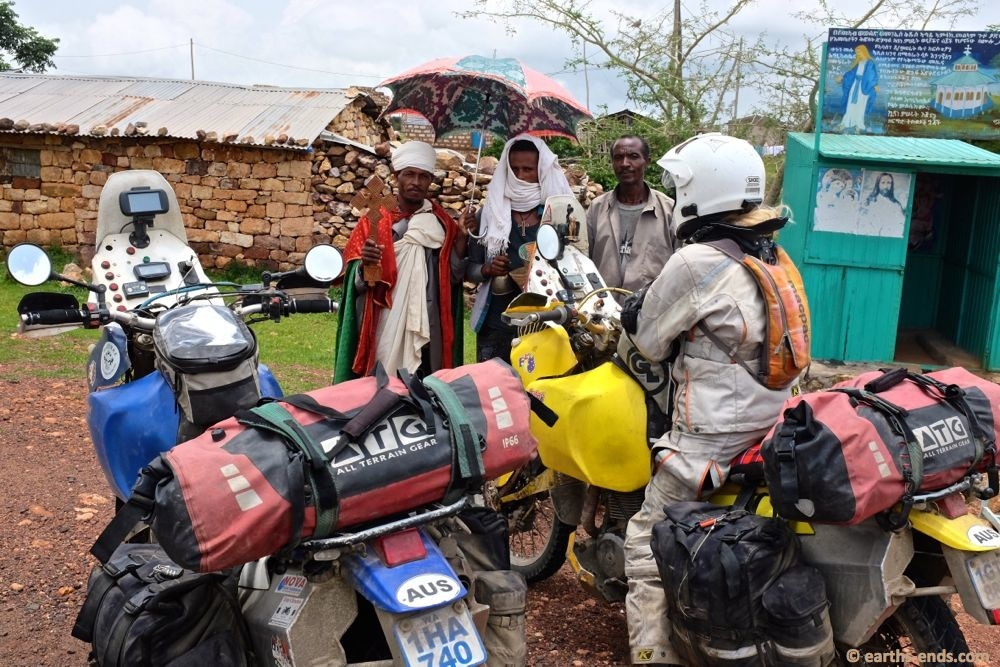
Good thing we got a roadside blessing that morning. This was a rather interesting thing about Ethiopia that priests would man a little post along roadsides to give roadside blessings. A couple of times we saw bus drivers stop in the road at one such stand and have the priest run out and give them and their vehicle an impromptu blessing.
As usual we were on high alert being in an inhabited area and my eyes were roving the road identifying hazards. I spied up ahead the only kid near enough to potentially run out in front of our path. He was standing on a rung of a large vertical metal pole at the very start of the bridge. It seemed unlikely he’d jump down and run across the road but I still kept my eyes on him. But just then I experienced a super sudden and overwhelming self command to crash my bike right there right now.
It was so strong a compunction and so instinctual I immediately did just that, grabbing the brakes and going down bloody hard on the dirt in the process. I landed over the side of my bike with my forearms and torso taking much of the impact. I was instantly sore having come down flat rather than sliding. But more than anything I was utterly flabbergasted. I knew 100% that I did that on purpose but had not a single clue why. For a second there I thought I must have gone and lost my mind. I remember trying to desperately figure out what I was going to tell Mick happened because at that point I didn’t have the foggiest idea.
Mick was right behind me and figured I must have hit someone or something. It was only when he went to pick my bike up that he realised there was a thin rope across the road. I had crashed the bike right beneath it to the point we had to hold the rope back to be able to pick up the bike up. The rope was maybe 3mm thick and red/brown in colour and had nothing at all hanging from it to allow it to be seen. We had come across plenty of ropes across roads in Ethiopia but they had always had flags/rubbish hanging from them. Not this time. Not at all.
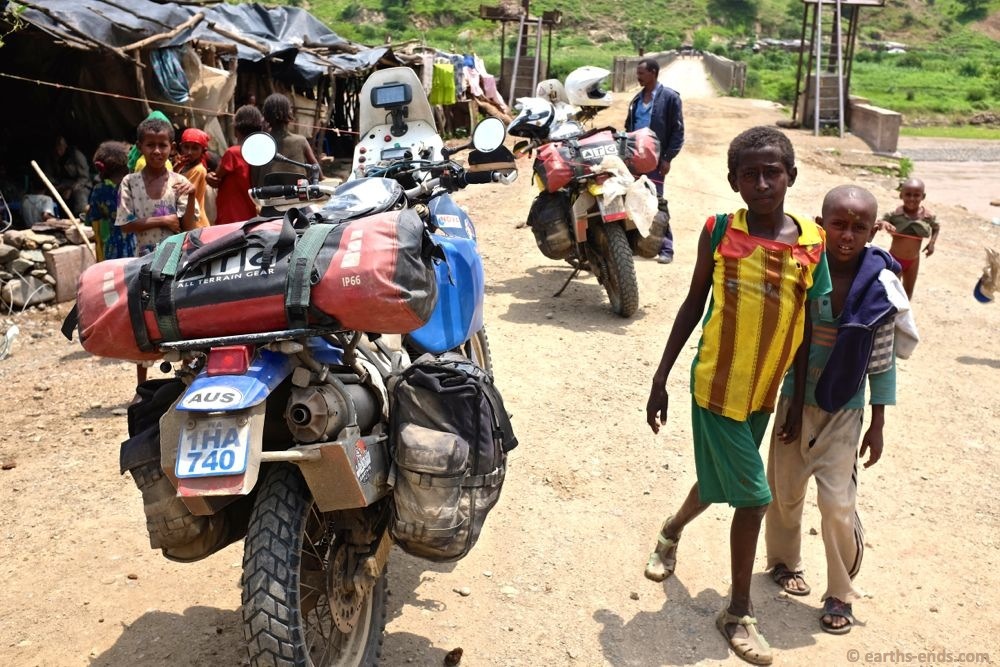
The culprit. Look and you will see the rope…..unless you are riding a bike at the time.
Right before the command to crash my bike came from nowhere I remember thinking of the word ‘metal’ with alarm. As I look back now the only explanation I have for crashing and not knowing immediately why was that I must have subconsciously seen the rope across the road before I had a chance to clearly develop the thought and recognition in my own head. The word ‘metal’ jumped out as I think I subconsciously realised that the rope might be attached to metal pylons in which case I couldn’t count of simply riding trough it… I don’t know for sure but that could be some kind of explanation.
It was an incredibly odd experience knowing you crashed on purpose but not knowing why. It was however confidence inducing in a way to have such an experience that suggested subconscious risk assessments as well as the conscious ones might be going on while I am riding. The rope was at about neck/helmet height so the most likely outcome had I not crashed the bike would have been it hitting my visor and getting caught under the peak of my helmet and pulling my head back and making me crash in a perhaps less than ideal manner.
Once we realised there was a scarcely visible, highly dangerous (to bikers) rope across the road we were a bit pissed about it. There were a handful of policemen guarding the bridge sitting down nearby doing nothing who must have known that something like that might well happen from the moment they saw us riding toward the bridge. We knew however not to confront them about it as we weren’t in a position to challenge them. The fact the guards all hung back and avoided us suggested they knew we might be unhappy at them. But the ladies and kids of the village came and picked me off the ground and patted my head and rubbed my arms and knees to see if I was ok.
I took my off a glove and hung it from the rope to tell them they needed to hang something from the rope so people could see it. One young boy was quick on the uptake and wrapped plastic bag around the rope. I gave him and thumbs up and showed him they needed to be all across the rope. Once the village women saw I was okay we all had a bit of a laugh miming my ‘near decapitation’ and inelegant stack.
As much as I wanted to leave the place I thought it best I sit down and have a coke and make sure I was felling ok. I was feeling quite sore, like I’d been crash tackled by someone twice my size. It hit me that I was so sick to death of crashing this bloody bike and would not be doing anymore of it. After my coke I was fine to go again. Only from then on I was seeing non-existent ropes at every turn.
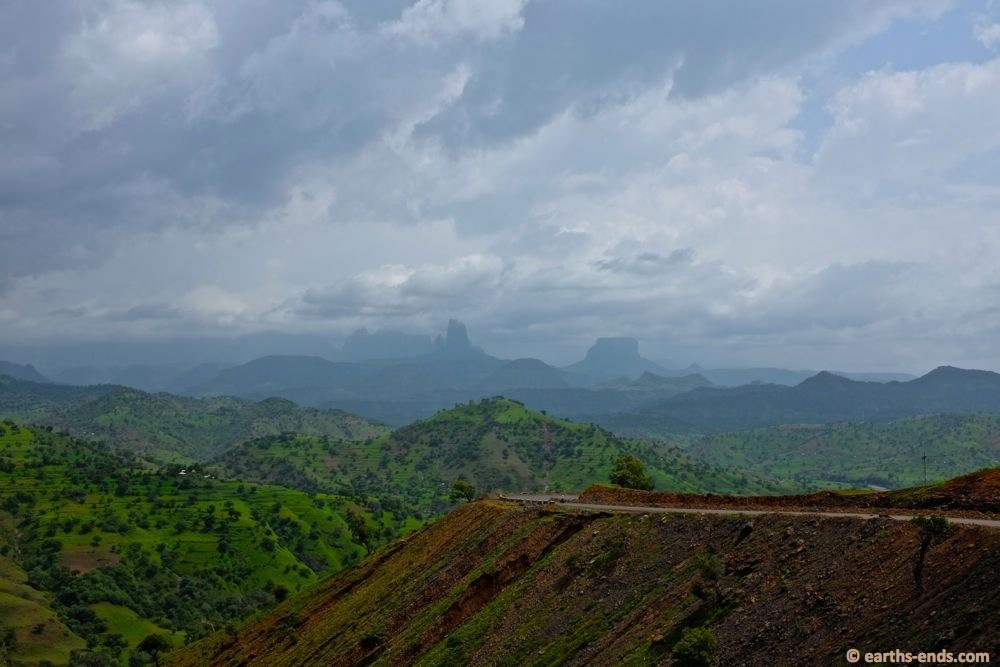
Approaching the Simiens.
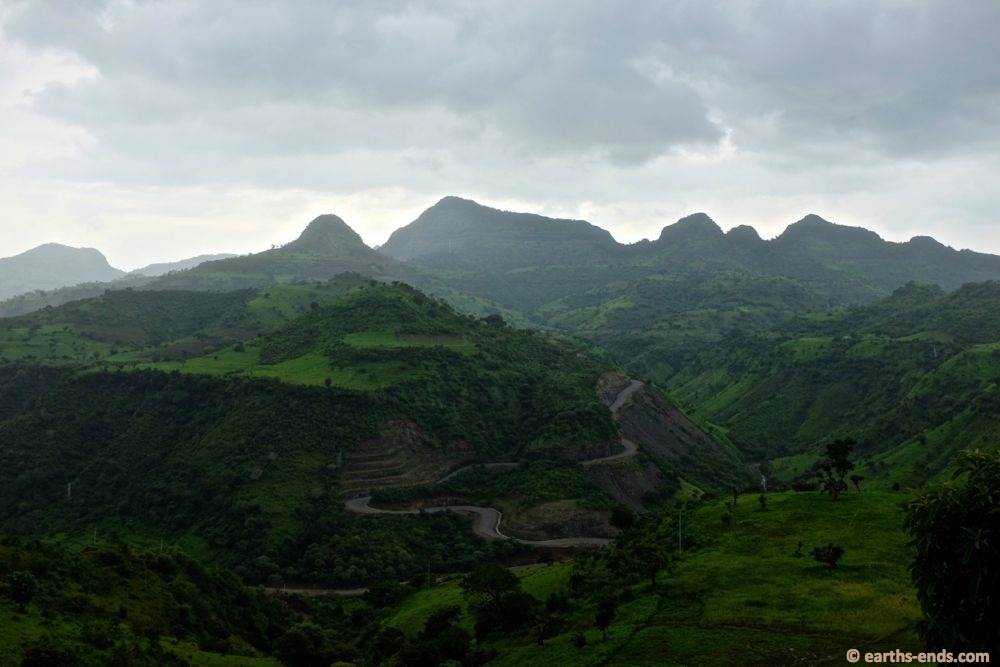
Them views.
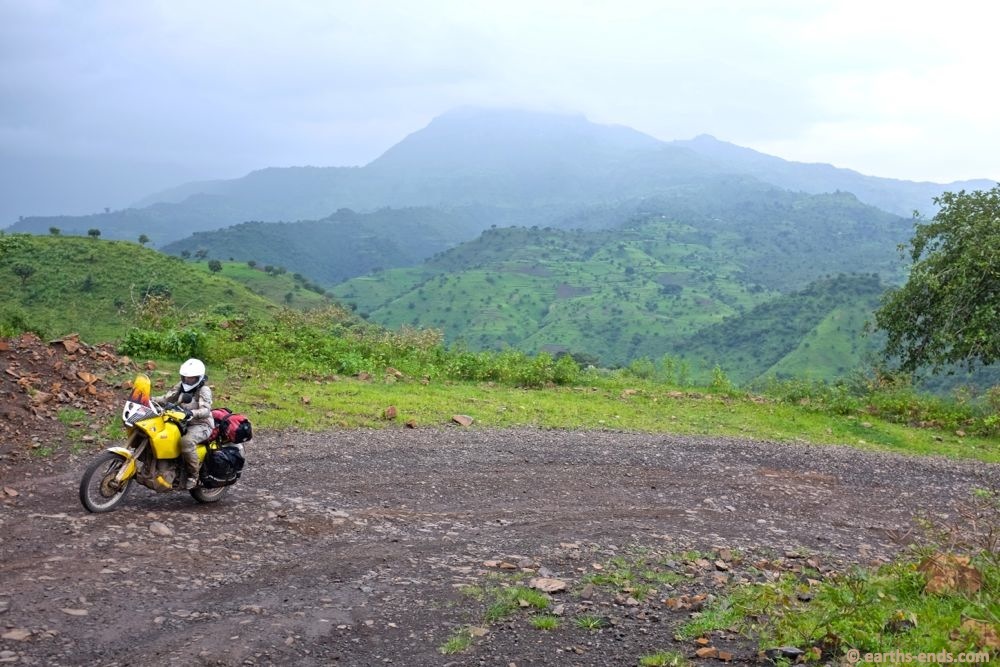
The tar was nice..but this was nicer.
However the fun and games weren’t over for the day. As we approached our next destination, the famed Simien Mountains national park we were given both hints of the amazing scenery and the threatening weather. Soon enough it started to rain heavily making us regret our initial indecision on whether or not to put on our wets. We eventually did but not before we were half wet through. The remainder of the ride was pretty wild and memorable as we finished the last portion of the unsealed road in torrential rain.
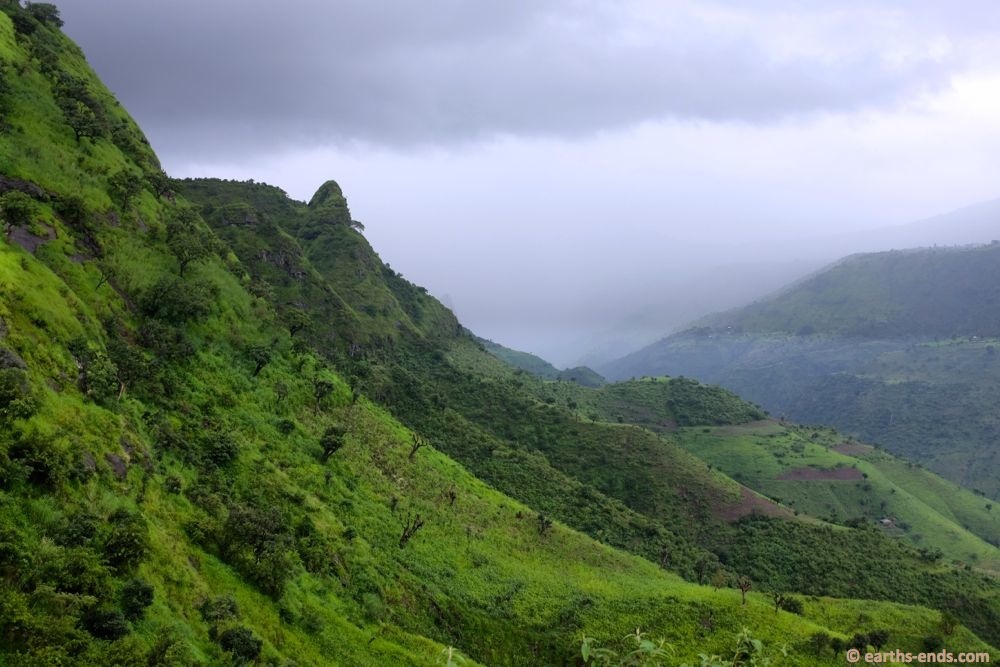
The weather looking menacing.
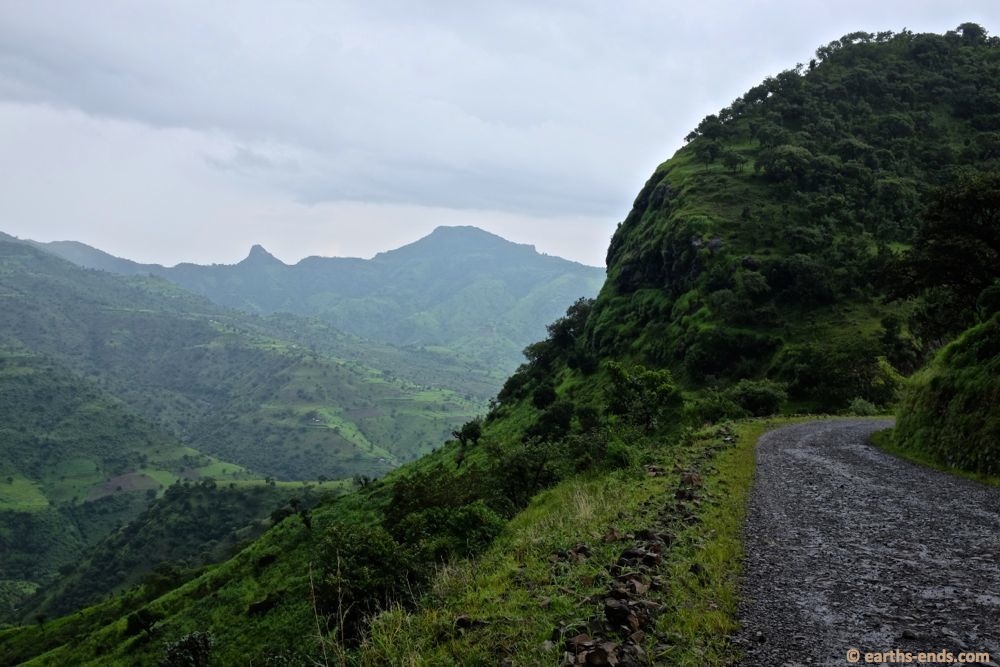
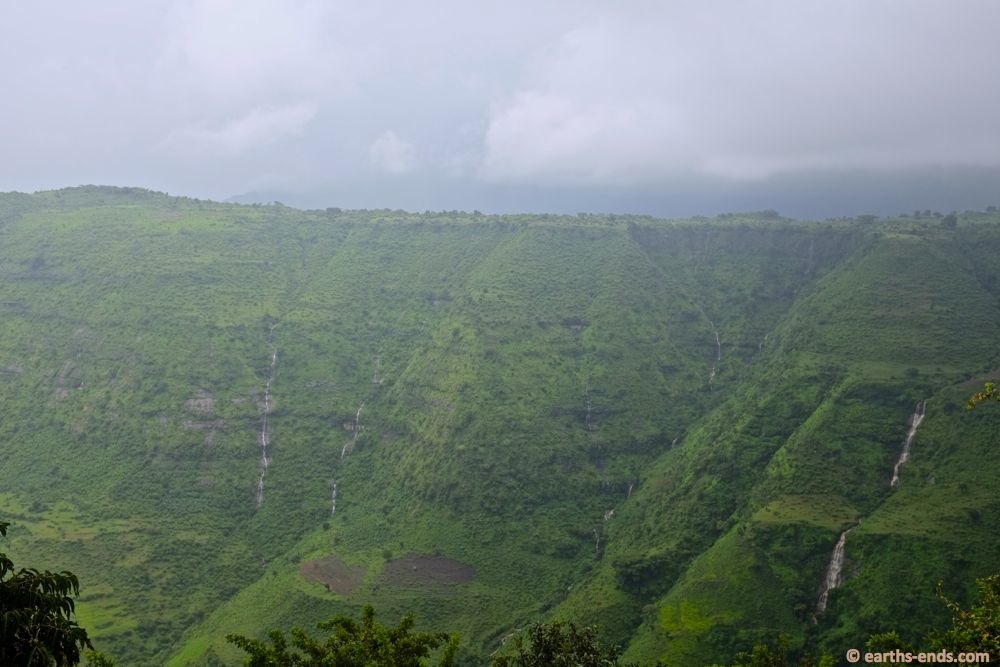
Waterfalls in the distance.
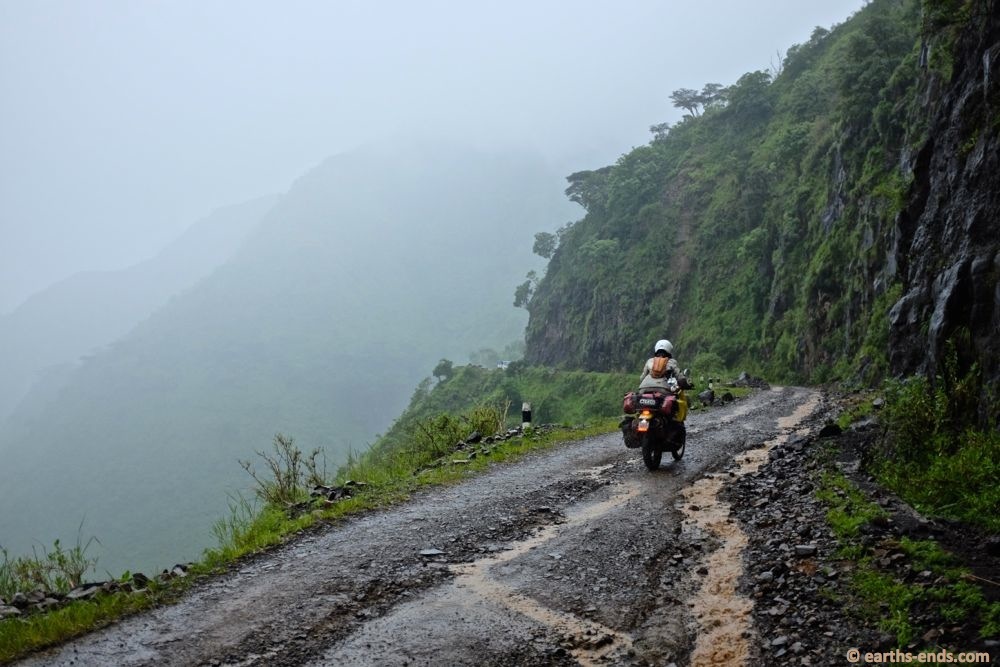
Raining now – cold, wet jocks all round.
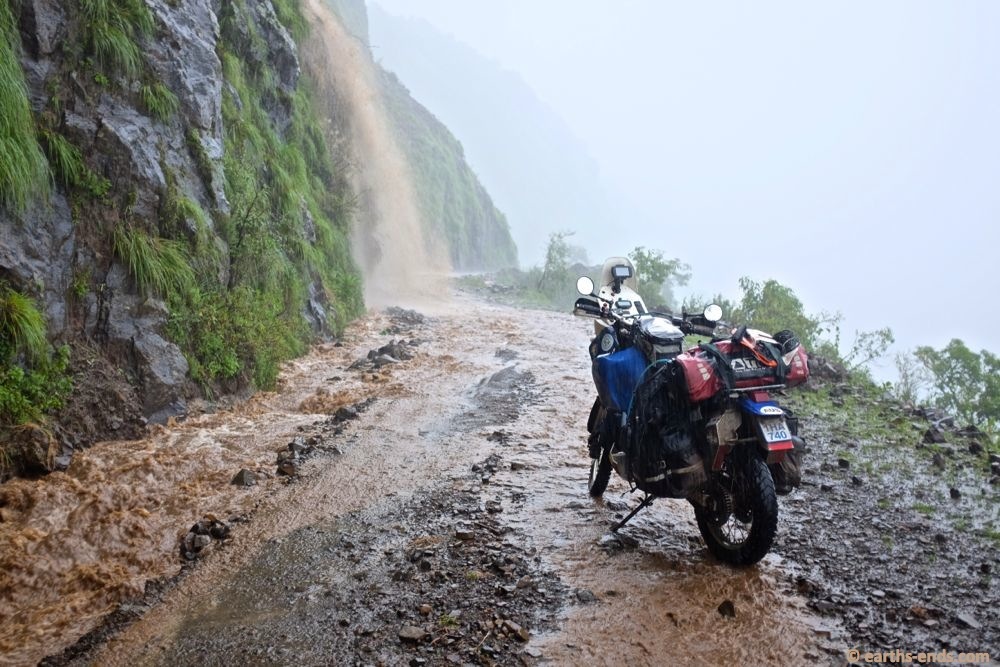
I was in front and Mick stopped to take this photo. When he didn’t appear behind me I naturally assumed he had ridden of the mountain and needed rescuing so rode back through it all to find him taking happy snaps.
Waterfalls were crashing all over the mud roads, our over gloves were filling up with water, visors fogging up, thunder rolling and lightening striking in the distance. No one wants to be in the mountains during such a storm. But soon enough the lightning calmed down and we rolled into Debark, the gateway town to the Simien Mountains National Park, soaked to the bone but grinning. We found a good room and set about drying all our gear. Even then I think we knew my much-anticipated visit to the Simien National Park might not be feasible or even enjoyable with the weather the way it was. But the Simiens were the scenic home of some rad looking monkeys (gelada baboons to be specific) that were in want of my gushing affection so we would cross our fingers for better weather (and dry riding gear) in the morning.
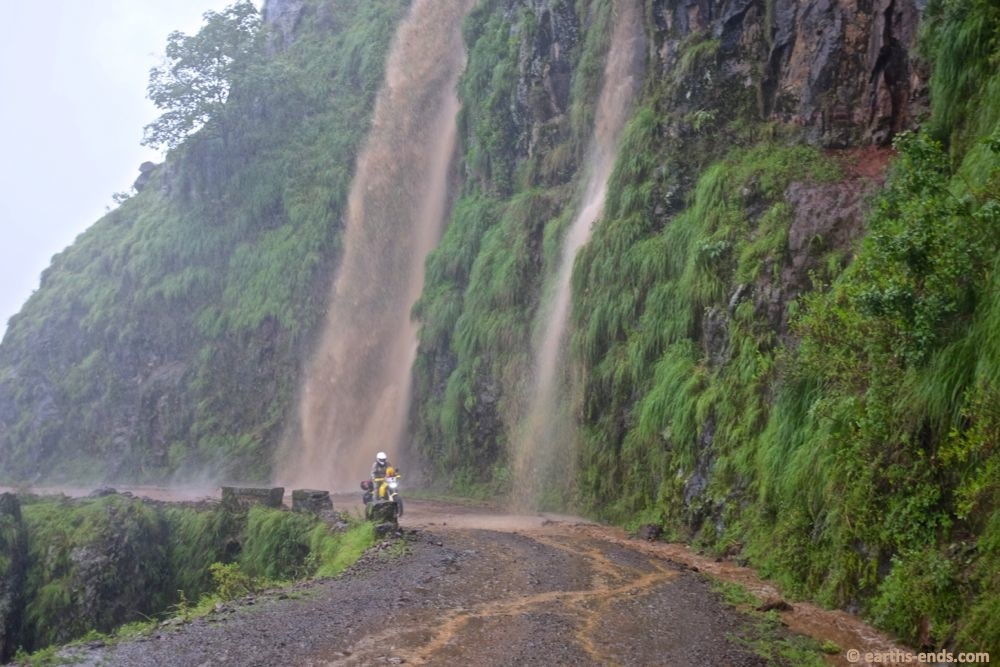
I was just happy that after more than a year of lugging it around Africa, I was finally getting to use my Klim suit in anger.
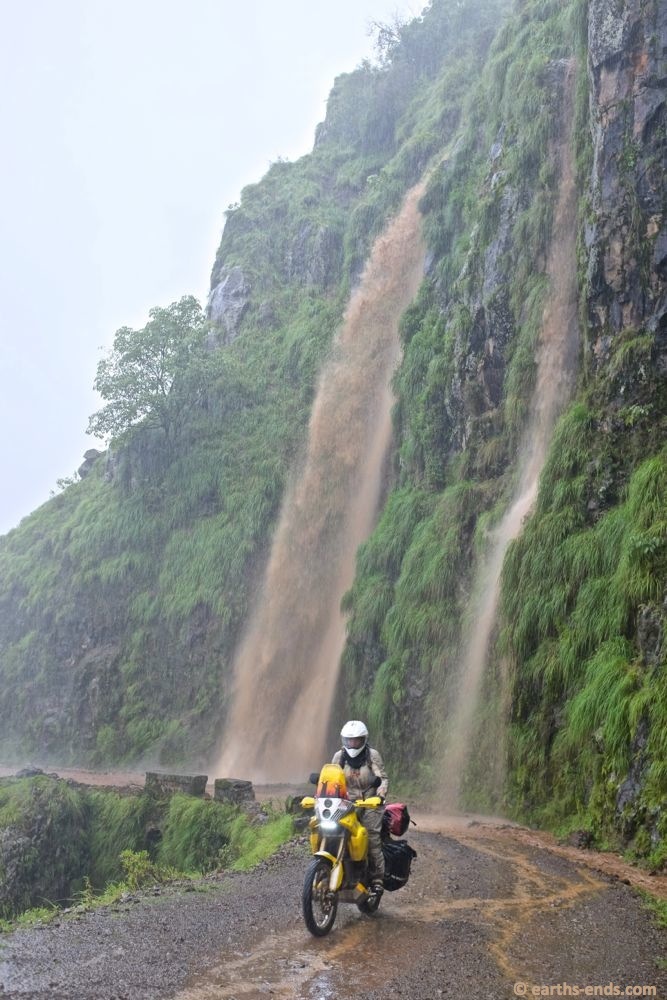
A memorable ride.

Blog 51 by Tan: The Geologists’ Nirvana of the Danakil Depression – PART 2
After next to no sleep the previous night we crashed out in anticipation of another early start for our visit the Erta Ale volcano (pronounced like Air-ta Ah-leh). In the morning I woke up feeling good… too good even. Yep, we had slept through our planned wake up and departure time. We were confused as to why no one had roused us and indeed why the others were also still in bed. Turns out we’d slept through the nights dramas.

Warning: This is another geology heavy blog.
In the middle of the night one of the Spaniards woke up physically ill and with a 40 degree fever. Having recently recovered from a case of malaria the guy was understandably worried about having relapsed. Luckily for him we were only 3 hours from Mekele where he was taken to a hospital for testing and treatment.
We hung around during the morning waiting to hear back about the tests and wondering what it meant for the trip. We expected that either way he would stay in in Mekele recovering, either in hospital or just a hotel, until the following day when the tour ended. After a number of tests he was declared malaria free but he was found to be suffering from giardia. As we had been eating carefully prepared communal food and only drinking bottled water it was hard to imagine that it came from anything but local sickly kids they were playing with… giardia has similarly objectionable origins as conjunctivitis after all.

Erta Ale location map
However we were surprised to learn that even though he was still being physically ill, he was on his way back to join the tour. And while a part of me did recognise it was a particularly brave man that left ready access to a toilet in the throws of a giardia spell, on the whole I thought it was an unnecessarily risky move. This next stage of the trip would have us far away from medical help on difficult terrain and in extreme temperatures all while this guy suffered ongoing vomiting, diarrhea and inevitable dehydration.
At a mine site I once worked at a delivery driver almost died from extreme dehydration brought on from heat exposure combined with food poisoning, and that was in lower temperatures than what we could expect at Erta Ale. When the delivery guy was found, delirious and passing in and out of consciousness, it was almost impossible to administer a drip as his veins were so collapsed, his urine was black and if he hadn’t been found he would have been dead within a couple of hours it was believed.
The last thing you want to be when going somewhere as hot and as far from medical help as Erta Ale is sick and dehydrated. This guy was still vomiting and feverish and would soon be in 40-50 degree heat 6 hours or more from a hospital, and we thought this maybe wasn’t such a great idea. We communicated this to his mates but it was obviously not up to us.

Views on the way – basalt fields and sand
By the time they returned and we hit the road we were 4 hours behind schedule. But while the day started out on quality tar roads, our progress was regularly interrupted for the poor sick fellow to stop and vomit and ‘the like’. Once we left the tar for bush tracks, things started to go pear shaped within the first few minutes. The area we were heading into is prone to flash flooding at this time of year when the rains in the highlands (much like we had the previous night) wash down into the depression. Here it doesn’t take much water at all to render large areas of fine silt a veritable quagmire, an example of which our rather inept drivers managed to find and immediately get bogged in.

The erratic driver of the Spaniards vehicle said right before getting stuck ‘we will get stuck if we go this way’ begging the question… why did he go that way then?
We watched as the drivers set about unbogging the vehicle and that was… well… you can see in the video below it was not an encouraging display. Mick has had enough practice with such things and his head almost exploded at the scene.
You have to put it into 4WD before it will act like a 4WD, see.
First they tried to pull the stricken 4WD out with our vehicle but lazily had both vehicles and the rope severely out of alignment. While hooking up the rope Mick offered some advice that the towing vehicle and rope should be pulling in line with the bogged vehicle, but they persisted anyway to Mick’s warning “this will never ever work”. The pulling vehicle with hubs unlocked and still in 2WD lurched hard as the driver dropped the clutch and spun the rear wheels, both vehicles then pulled sideways violently as the rope took tension and then promptly snapped. Not a great start, and sadly, easily predicted.
The driver tied up the snapped rope and straightened the vehicles, which had the benefit that the rope didn’t snap a second time, however as it was still in 2WD so all this attempt produced was lots of dust. Mick suggested they might like to try the magical powers of 4WD, but they chose to hookup the second vehicle instead. With this attached at a sharp angle it added little pulling power and with the first vehicle still in 2WD, all they managed this time around was yet more dust (as per the video). Mick stuck his head in the cab pointing at the transfer-case lever and proposing 4WD, but when both drivers got out of the vehicles scratching their heads Mick’s frustration got the better of him and he locked in the hubs and engaged 4WD himself.
Maybe it was just a weird coincidence, or maybe all that head scratching had more of an effect than we gave it credit for, but this time the bogged vehicle was miraculously pulled from the mud. It was hardly a reassuring performance… and a bit of an exhibition of what was still to come.

Bogged again….

And again……
After the initial totally avoidable bogging event, it was our Landcruiser with its narrow and thoroughly bald front tyres getting bogged all the time. A pattern started to emerge. We’d get bogged, the drivers would immediately hitch up the crappy nylon rope and do no digging or any other preparation work, Mick and myself would get out and push, the rope would snap, we would grab the shovel and dig while the rope would be tied again, push again, the rope would snap again, and so on and so forth until the vehicle would be freed… only to do it again 20 minutes later. That is US$450 worth of guided tour right there.
We eventually made it to the small Afar hamlet Araboro where we would have lunch, pay the local community their dues and pick up our police escort. It was 4pm and we were hungry, hot and tired, not to mention aware we hadn’t even started the hard part of the drive yet… and then there was the small matter of the volcano climb.
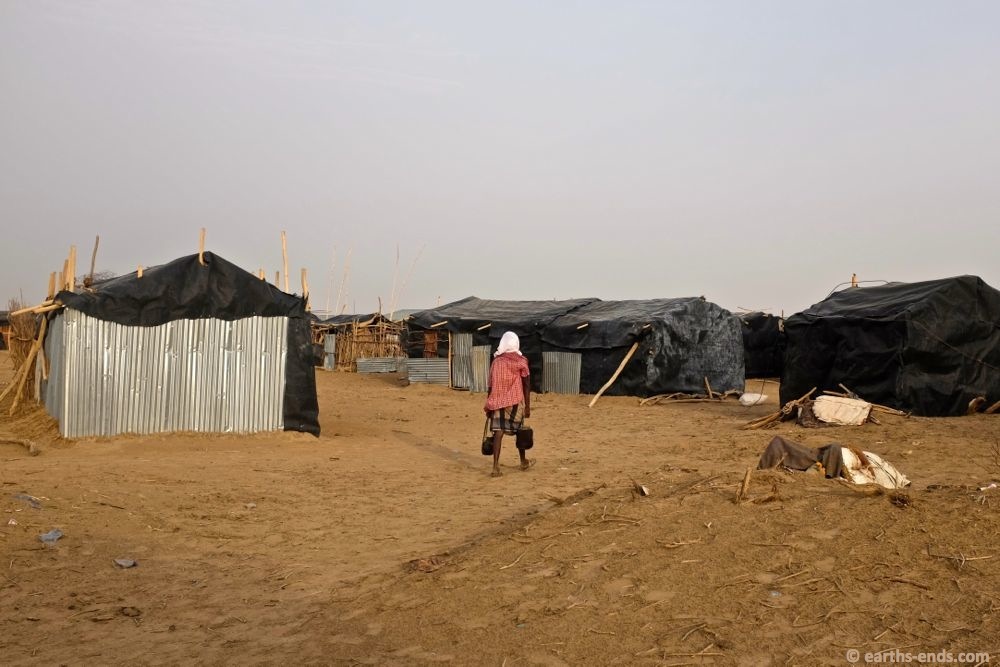
At Araboro where the local cook had prepared a generous and excellent cold pasta dish before hitting the road again.
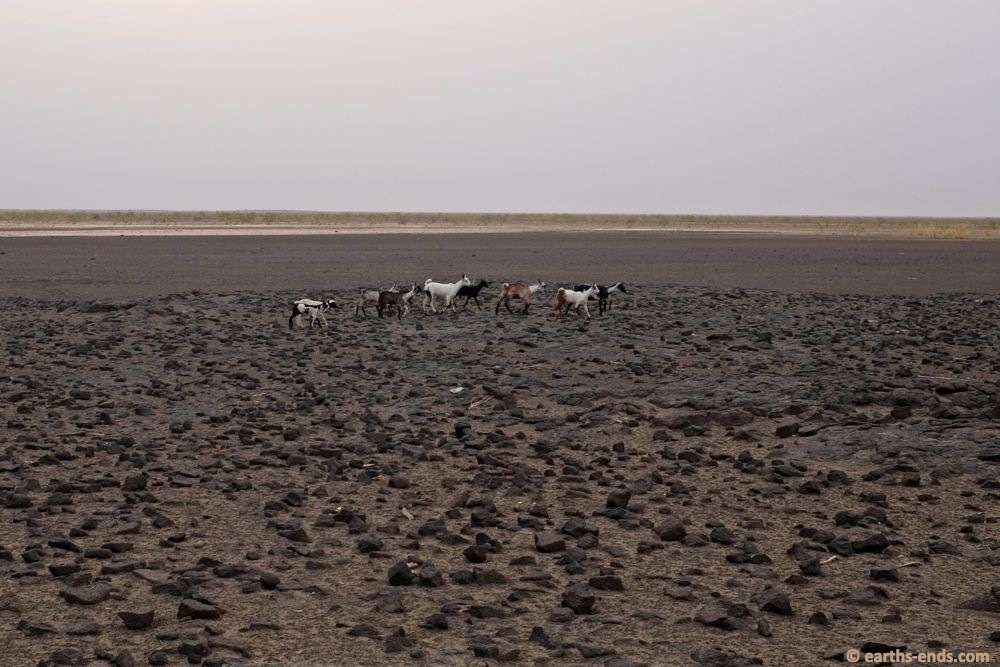
The first contact with the basalt. Tough place… even for a goat.
After our late lunch and what were some heated arguments regarding money between the guide and villagers, we were hustled into the vehicles and were on our way. Due to the rain from the previous night we learned we would have to take the difficult alternate route to the volcano, bypassing the wet silt and driving over basalt lava flow. We soon understood why it was that most tour agencies would rather cancel the trip in the event of flooding than use the bypass; the vehicles get absolutely brutalised. We only made it though the first small section of basalt field before the third vehicle (a 76 series troop carrier) broke a tie rod. With one of the front wheels disconnected from the steering wheel, it was not going anywhere. The sun on the other hand was still on its way down, making it painfully clear we’d be navigating an infrequently used route over hellish basalt lava flow in the dark. This was most definitely ‘one of those’ trips.

Boy do these Afar live a hard life. This is one of the more extravagnet dwellings. I am not being facetious.
With one car out of action, the Afar policeman were squeezed into our ‘cruiser with the cook and our guide overflowing onto the roof rack. We continued on our way alternating between rough as guts basalt field and sandy gravel beds. And then we got well and truly stuck on a rise on the track that ruled out the go-to extrication method of mindlessly pulling the vehicle out of trouble.

Mick after a less than impressive vehicle extrication. This is Mick’s ‘I am seriously not impressed’ face – familiar to and feared by all those that have dated, worked with or reverse parallel parked in front of Mick.
Mick and I had been frustrated by an interesting cultural quirk we had observed in our guide and drivers. They refused to get their hands dirty… more specifically it seemed they could not possibly bring themselves to do manual work. For us, you prepare a vehicle for extraction first by digging out bogged wheels and placing rocks for traction before towing. But no matter what, they would go straight to the tow rope, a sure fire way to bog the second vehicle or snap the tow rope. It seemed they thought it wasn’t for them to get their hands dirty in this manner, that was for people on a lower rung of the social ladder than them… or shitted off foreign tourists like us with no such qualms.

Behold the unforgiving terrain we got stuck in! If we got stuck in this small pile of gravel you can imagine how we fared in the actual tough stuff.
However in this instance, with no way to get a second vehicle in front to tow, the driver reverted to pushing harder on the accelerator pedal achieving nothing but spinning wheels further bogging the vehicle before he was yelled at to stop (by us). Mick and I started piling rocks under the tyres while the driver and guide did pretty much nothing but watch. This time a couple of the Spaniards even chipped in. Mick could see the right hand side of the vehicle needed to be weighted to get traction, so he arranged himself and a couple of the Spaniards on the rear and side of the car and jumped up and down while the driver gunned it out to freedom. The drivers, guide and cook jumped up and down and clapped as they had never seen something like that done. They excitedly told Mick that he ‘was so good at that, you could do it for a living.’ An unimpressed Mick replied ‘good, because I expect tips at the end of this!’

Mick earning his tips.
And on it went, over some of the roughest terrain we’d ever come across in a 4WD. We were thankful these weren’t our vehicles as they were taking an absolute thrashing, bottoming out and bashing the under carriage multiple times on the basalt that went on forever with no reprieve. Having the guide on the roof rack proved to be a necessary action as he was the only person high enough to see the dusty tyre tracks of the trail over the lava flow. Even then we ended up off the ‘trail’ a couple of times, which meant we bashed our way through the basalt following the Afar policemen who led the way on foot. It was slow going.
You can do self-drive Danakil tours, where for half the price you tag along with a tour group. Our friends Karen and Pete (http://blog.tracks4africa.co.za/category/cape-to-the-carmine-c/) took their 4WD Hilux on such a tour and they found the standard Erta Ale route was rough on their very well equipped vehicle and had a rear shock absorber mount shear off. If you were to take your own vehicle it ought to be in full working order. And if it floods and they want you to take your car on the bypass to Erta Ale the smartest thing you could do would be to turn around.

What the terrain was like. These aren’t our pictures but that of one George Kourounis it appears.

It is only relatively recently that people could ‘easily’ visit Erta Ale volcano. Up until 2002 you could only access the site by helicopter. Now you can get within 10km by car. The rest of the distance is covered on foot or on the back of a camel.
We arrived battered by the drive at the Dodom military camp that also serves as the base camp for the Erta Ale climb. Security as I mentioned earlier is a real issue in these parts with the Eritrean border just a stone’s throw away. In 2012 a group of 27 tourists hiked up the volcano leaving the military guards at the base of the climb. On the way down they were attacked by approximately 40 armed men. Five Europeans were killed in the process, a couple more seriously injured and another man kidnapped and taken into Eritrea and released a couple of months later.
Ethiopia claimed the Eritrean military were responsible, while the Eritreans say it is the Ethiopian Afar separatists, which is an easy blame game indeed as both groups have in the past kidnapped and killed tourists in the region. Suffice as to say it is not the safest of places to visit, though these days there has been a major boost to security, with all tourists escorted by armed Afar Policemen and regular army patrols near the Eritrean Border.

A photo of the Dodom military camp taken by our overlanding friends Pete and Karin who did a Danakil tour about a couple weeks before us. You can (and should) find their fantastic blog here (http://blog.tracks4africa.co.za/category/ethiopia/).
After arriving at what must be the most miserable military postings on the planet, we laid down our beds for a spell while the cook prepared dinner. Tours usually arrive in the base camp in the afternoon which allows for a rest before the 3 to 3 ½ hour climb which generally departs around 7pm with a couple camels lugging sleeping gear. Having arrived exhausted after 10pm we had just an hour of broken sleep before eating dinner and setting out on the hike at around midnight with no camels and therefore no sleeping gear.
To our wonder the sick Spaniard was determined to do the hike and despite having to vomit periodically along the way he managed the climb better than I did. In my defense I was pushing bogged vehicles all afternoon… plus I’m not fit sooo… It was a tough hike due to intense heat and the difficult terrain of pure basalt, which was tricky to negotiate under a narrow beam of a head touch. In a little under 3 hours we found ourselves within sight of the glow of Erta Ale’s crater.

Ther’ she glows
This volcano is indeed a special one. Far from the commanding presence of your average stratovolcano (think Mt Fuji, Etna, St Helens etc), Erta Ale is a shield volcano with long gentle slopes – though my spasming glutes and calves on the ascent suggested otherwise. Shield volcanoes (think Kilauea) typically form through non-explosive eruptions and are not steep due to their highly fluid (low viscosity) basalt lava flows, as you obviously cannot pile up something that easily flows downhill. It is also for this reason that shield volcanoes tend to have a very large size (sometimes 20 times wider than high) and have a low profile resembling a flat lying warriors shield, hence the name. They are a result of high magma supply rates such that occur over hot spots, magma plumes or divergent plate boundaries for example; the last of which is the reason why they exist in the Danakil area.
What makes Erta Ale particularly awesome is that it is one of the few volcanoes in the world with a lava lake. Usually when you are see magma in a volcano crater you are looking into the magma chamber itself and when you are seeing lava it is what has been extruded from that chamber be it through eruptions of the volcano of from its dykes and sills. Lava lakes are altogether different as they are a reservoir of lava connected to but distinct from the magma chamber. Lava lakes are exceedingly rare and oft short-lived geological phenomena. At this point in time there are but 7 lava lakes in 5 places on Earth, which are;
- Kilauea, Hawaii (where there are two lava lakes in two different craters)
- Erta Ale, Ethiopia (the oldest and sometimes has 2 lava lakes though only one at the moment)
- Ambrym, Vanuatu (like Kilauea there are two lava lakes in two different craters of the volcano)
- Nyiragongo, Democratic Republic of Congo (the largest and if things go to plan it will be the second lava lake we get to see)
- Erebus, Ross Island, Antarctica (so Buckley’s chance any of us will see it)

The lava lake at Erta Ale is the oldest lava lake on Earth having first been observed in 1906.
The reason why lava lakes are so rare, and short-lived when they do occur, is due to the unique set of requirements for their existence. Lava lakes need constant magma circulation through the entire system (from chamber to column to lake surface). If convection is interrupted heat loss occurs which causes lava to solidify on the surface of the lake to the point the lake ceases to exist. For Erta Ale to have avoided this heat loss and solidification issue for a hundred years, it is believed the lake must have an unusually shallow magma chamber (less than 1km below the volcano). And this magma chamber likely benefits from higher than ‘normal’ rates of magma due to its proximity to the rift where plates moving apart leading to an upwelling of magma at the boundary.

The view at the top was certainly worth the hike.
By far the coolest thing about the lava lake is that it serves as a hyper accelerated, real-life analogue for the mechanics of plate tectonics. The enormous source of active magma beneath Erta Ale in this analogue represents the convecting medium of the Earth’s upper mantle. Note however that the upper mantle of the Earth is not actually liquid magma, it is just convecting in the same way the lava of the lake does; stuff down low gets heated, hot stuff rises, stuff up top cools, cool stuff goes down, gets heated, rises and over and over we go. The cooling lava on the lake surface is the equivalent of the lithosphere or Earth’s crust. As you can see in the photos the surface of the lava lake invariably cools to the point that a ‘skin’ of black solidifying almost basalt appears forming a number of slabs, the margins of which creates the appearance of a jigsaw puzzle pieces separated by a strip of glowing lava.

There were a couple of occastions when lava fountain spurted on our side of the crater and had us scurrring away…only to inch closer as our bravery returned.
The convection of the underlying lava moves some slabs towards each other (convergence in plate tectonics lingo) where one slab would inevitably prove more dense than the other and summarily slip under the less dense plate and subduct into the depths of the lake, where it melts and continues the cycle. In other parts the convecting cells of the lava lake move the slabs apart (divergence in plate tectonics lingo) and in much the same way a spreading centre on an ocean floor performs, lava upwells and cools and solidifies.

A rad diagram – the bottom left corner illustrating the the workings of convections cells in the mantle
The real life process of plate tectonics occurs on an impossibly large scale, over impossibly long periods of time that we humans can’t even begin to appreciate, with plates moving at little more than 1cm per year on average. Here on the crater rim we stood watching the model equivalent of tens of millions of years worth of movement happening in minutes. To geologists and non-geologists alike, it makes for riveting viewing.

Here you can see the ‘crust’ forming on the lake as it cools on surface. The insulating properties of the lava crust reduces the temperate to 200’C down from 1200’C during high convection/activity. Here you see a section ‘crust’ taking a dive back in to the lake.
Another very exciting part of visiting Erta Ale was being able to watch the formation of a not all that common volcanic product called ‘Pele’s Hair’. We had seen Pele’s Hair just once before while visiting the Mt Yasur volcano on the island of Tanna in Vanuatu. Pele’s hair is most commonly (though not exclusively) produced in eruptions of basaltic volcanoes such as those often found in Hawaii, and is named after the Hawaiian goddess of fire and volcanoes. Pele’s Hair is essentially volcanic glass that forms when lava (especially high silica-low viscosity lava) is ejected into the air. As the airborne lava falls it cools and separates with parts drawn out into thin threads which then solidify into a fine, hair like strands that get captured by wind and hot updrafts and scattered around the crater rims. In the video of the lake you can clearly see Pele’s Hair forming after ‘fountaining’ in the lake, where lava spurts several meters into the air.
Watch closely and you’ll see whisps of Pele’s hair forming and wafting by in this video.

Pele’s Hair – not that strange a name when you look at it. We had to steal this photo of the internet – we did have photos but no longer…a long story we’ll get another time

Pele’s Tears. There were plenty of these around as well.
Pele’s Tears are a similar product as Pele’s Hair in that they are small pieces of solidified drops of lava making them a form of volcanic glass aka obsidian aka dragonglass (for all Game of Thrones fans). Formation of Pele’s Tears or Hair is related to the velocity of the erupting magma/lava; high velocity = hair and low velocity = tears. Both types were prevalent around the volcano and it was rather exciting finding 2-inch thick mats of accumulated Pele’s Hair.
In terms of activity Erta Ale is the most active volcano in Africa. Though thanks to its isolated location and fact it is a basaltic volcano (relatively innocuous, dare I say it), its eruptions in 1897, 1903, 1940, 1960, 1967 and 2005 caused no direct loss of human life but took out several hundred livestock which would have been pretty devastating a loss to the pastoralists of the area. In 2007 during an overflow event, thousands were forced to flee and two people are said to have been killed along with another round of mass livestock deaths. These lava lake overflow events can be huge hazards to those living around such volcanoes. As previously discussed, lava lakes require a massive source of magma to keep the system in constant convection… and therein lies the danger. The Nyiragongo volcano in the Democratic Republic of Congo has the world’s largest lava lake which is composed of highly siliceous (therefore highly fluid) lava. In 1977 the volcano sent copious amounts of lava down the steep slopes, where it travelled at speeds of 100km per hour. 70 people were killed in the event.

This is obviously not one of our photos but I thought it was so good I’d share it and hope Joel Santos doesn’t mind.
Erta Ale is currently in a low energy phase of its life, although it is consistently active which I found far from reassuring. I’m a gutless geologist in that volcanoes make me nervous to the point of fear. I was happy to see it but keen to keep exposure to a minimum. Yet even still I was gutted with the decision to leave the volcano after just an hour.

Erta Ale from above, behold a rift(random net pic).
Most tours take camels carrying mattresses and supplies to the top of the volcano where people rest until the night and early hours of the morning and in so doing witness the volcano by night and day. Due to us being far behind schedule and the fact we were running on 1 hours sleep, had no sleeping mats and would need more driving time than normal to return, the decision was made to head down after just a short time. I was content enough to leave the actual crater rim for a while, however I was utterly devastated to miss seeing the place in the light of day.
Everyone else had seen the exciting, colourful lava lake stuff and now just wanted to sleep and the guides just wanted to get back to Mekele. Mick and I were outnumbered in wanting to stay so I was in epic sulk mode while walking over vast fields of basalt structures I had been eager to see. I’d read about and seen pictures of piles of ropey pohoehoe basalt that dwarf a person and was excited to see them first hand. Imagine my frustration knowing I was walking over many of the things I wanted to see but couldn’t due to the inadequate narrow light of my head torch. I was highly disappointed and my field book was depressingly empty.

Here is another photo from the net that shows the crater edge where tourists traditionally get some rest before walking once again to the edge of the lava lake for a day time viewing.

This random internet pic shows some of the basalt texture we walked over but missed seeing.

This is an example of the ropy pahoehoe basalt I was hoping to see. It forms as the surface of a lava flow cools and becomes less fluid and more viscous. The surface of the lava wrinkles and bunches up to form what looks like ropes as the lava beneath continues to flow.
The walk down was completed in a little over 3 hours, which had us rolling into the military camp just after sunrise. We were hot, filthy and utterly sleep deprived. While the cook was getting our morning meal together we broke out the wet wipes and cleaned as best we could, changed clothes and crashed out for an hour of sleep.

And here you can see more of the same textures in the solid basalt.

Sunrise and almost back to the camp and the same texture again.
After another stellar breakfast we were back in the cars negotiating the hellish route back to the main road. The return drive over the basalt field was brutal, hot, slow and neck ache inducing. But this time the drivers were driving sensibly and could see where they were going so it was nowhere near the ordeal of the previous night. After a while we made it past the basalt fields to the fine silt of the desert where it was amateur hour all over again.

We were feed very well during the tour.
The desert is made up more of silt than sand so old vehicle tracks invariably get covered over with the hot desert wind. So the drivers head south to the highway following random tracks where possible and their nose the rest of the time until they eventually hit the tar. The desert winds kicked up and we found ourselves driving through a sand storm with very little visibility and we were worried about the cars getting separated.
We had a few minor boggings that we had managed to pretty swiftly extricate ourselves from with some quick digging and pushing, with even the guide chipping in from time to time. I think the heat and lack of sleep had increased his drive to get back to Mekele, although it had the opposite effect on the Spaniards who slept in the air-conditioned car as we toiled. Just when Mick and I were near stuffed our 4WD got bogged again. It was a significant bulldust hole that even a car with decent tyres could easily get stuck in. Mick who’d assumed the bulk of the vehicle extrication work was utterly destroyed and could scarcely bring himself to get out of the car. I went and checked out the extent of it and was finally worried.
We were bogged in deep rutted bulldust up to the chassis. The stakes were higher today than the day previous as everyone was hot and fatigued, we had lost the third 4WD with the broken tie rod, we were down to about six 1.5 litre bottles of water for 10 people (one of them very sick and a few of us working hard), and to top things off the two crappy nylon tow ropes had been snapped and retied so many times they more resembled a multi coloured frayed mess of knots that one finds washed up on a beach. While it was only mid morning, it was already sweltering and things were only going to get hotter. We couldn’t afford to be stuck here for long.
So while we were waiting for the lead driver to realise we were no longer following and come back to assist with the recovery, we figured we best start digging. ‘Where is the shovel?’ I asked the guide. Turns out our primary vehicle extrication tool, the humble shovel, was still in the broken vehicle that was left abandoned on the basalt. Mick wanted to throttle him… incidentally that is where the last of the water stores were as well.
After a lot of pushing and digging with empty water bottles with the ends cut off, we eventually managed to get the car out of its dust trap. In doing so they snapped the shitty nylon ropes a couple more times, the last time after the bogged vehicle had been pulled out of the dust hole but the driver turned left whereas the pulling driver turned right… you don’t have to be a rocket surgeon to know a rope between 2 vehicles travelling in different directions might break. The drivers were so incompetent and the repaired tow ropes so damaged there was now only one usable piece that was so short it was only a matter of time before something really stupid happened like they crashed into each other.
While pushing the car out I lost my shoes in the sand so had to search for them. By the time I found and dug them out, wouldn’t you know it, the second car with its half insane erratic chat addicted buffoon of a driver is GONE. He gathered up the snapped rope and just drove off into the dust storm. WHAT THE F_@K! Until this point we had dealt with considerable patience/disbelief with the level of ineptitude we had never thought possible. But now I was feeling distinctly homicidal.
The Spaniards later informed us that they had yelled at him for leaving and tried to get him to turn around but the nutter was adamant we would find them. The logical thing for us to do would have been to stay put and wait for him to return while hoping like anything he didn’t get bogged in the process. But our driver started driving off into the dust storm in our bald tyred bogging wagon to look for him. We gave the guy an ear full to stop and phone the nutter… This is Africa, there is phone service everywhere after all.
By the time our driver found the right number and they had yelled at each other for a while, they had the inevitably fruitless conversation of how to find each other in the desert without a GPS, vision in the dust storm, landmarks in the desert, compass or common sense. ‘WHERE ARE YOU!!!’ ‘I’m in the desert driving through dust past that pile of sand on the left, right next to the sand on the right, with more sand in front, where are you?’ We had our GPS with us recording our tracks so we could always navigate back to the highway, it was just whether it could be done without getting stuck that was in doubt. Eventually the dust storm cleared enough that we saw the car driving around a couple hundred metres from us, we met up and the guide and the other driver yelled a lot while Mick and I sat SEETHING in the backseat. We again realised that we struggle to travel with people that don’t have a similar risk profile as us.
We were simply not at all accustomed to dealing with such levels of incompetence in such a harsh environment. In Australia and in our former line of work, going out in a desert is a serious business. We are indoctrinated to have a more than healthy respect for heat, water scarcity and remoteness. One does not forget the shovel. One does not forget the water. One doesn’t act like a muppet. This drive to and from Erta Ale, where nothing drastic actually eventuated, was rather frustrating for us as a result. We weren’t upset about unbogging vehicles it is just that it was all so avoidable. Some people might have found it an ‘adventure’ – we saw it as unnecessary bullshit.

Salt works building by the lake
After eventually hitting the tar we travelled to Lake Afrera to experience its hypersaline waters. It was interesting to see more modern salt mining practices around the lake. At these operations the briney water is pumped into large artificial plastic lined ponds where it is evaporated leaving the salt to precipitate. After putting away a meal and a bunch of cold cokes we in the cars on our way back to Mekele and the tour was officially over.

We didn’t swim as we weren’t keen to expose our scratched legs from our midnight climb in a lava field to the 37% salt waters of Lake Afrera.
Despite our aforementioned frustrations, the tour of Danakil was a huge highlight of all our travels in Africa. It was certainly worth the expense of the trip as there is simply nowhere on Earth like it. I would certainly recommend it to anyone considering doing the tour. Even for those without the slightest interest in geology (you poor miserable souls) the Danakil Depression holds massive appeal in terms of extremes of the environment the unique sights to behold. It is a true wonder of the natural world and should be seen by anyone who can swing it. Avoid doing it in summer.

Blog 50 by Tan: The Geologists’ Nirvana of the Danakil Depression – PART 1
The people who had previous expressed a keen interest in the geology tidbits offered up in this blog may come to regret such assertions. I am going to engage full geologist mode all up in this blog post as it seems only fitting for a report on the Danakil Depression, which would have to be one of the most unique geologic areas on the face of this great planet of ours. So prepare to be astounded or… mildly interested… or mind numbingly bored depending own your particular interests. I will try to limit geo-jargon and won’t be referencing anything as I am a civilian now and couldn’t be bothered. Suffice as to say everything I tell you about Danakil comes from the scientific exploits of many clever geologists before me.

Stand Back
We had made the decision to spend a huge amount of money on a 4-day tour of Danakil Depression some time ago. Still it was hard to reconcile the fact that we long-term unemployed vagabonds were about to drop a hefty $US500 each on it. We rocked up to Mekele, the departure point for all these tours, in the hope that we could swing a bargain by getting in on a tour at the last minute. Chances were good that any tour departing in the off-season would have vacancies on it, though the chances were equally good that there would be no tours going at all. However we were lucky enough to stumble across a tour company with a tour leaving the very next morning and they were willing to give us an off-season rate of $US450 per person. Sorted.
Our timing of our foray into the Danakil Depression was far from ideal… in fact it was the worst possible season as we were there in the height of summer and Danakil is a hard enough place to endure in winter. With areas as low as 120m below sea level we could expect temperatures in the order of 50 degrees Celsius (or 122 Fahrenheit to those that way inclined). I believe a record high of 67 degrees C was once recorded there but never officially verified. I’m guessing because any witnesses promptly burst into flames.

And some of what I say might even be right…but I make no guarantees
While both Mick and I have experienced such extremes temperatures on remote mine sites in Australia we had to confess that at times the mercury pushed 50 we would just sit in our air-conditioned offices, eating frozen popsicles and doing bugger all work. No such respite would be available to us on the Danakil trip as we would be camping, hiking and travelling vast distances in a car with an air conditioner that will invariably be bested by the Hades-like environment.
We had been dead keen to ride our bikes on the tour but knew it was a completely foolhardy option this time of year. Those are proper temperatures. Despite the easy terrain we knew we could never enjoy travelling in convoy with 2 slow moving 4WDs in such heat. So with a heavy heart we found a place to leave the bikes. And thank goodness we weren’t stubborn in our desire to ride, as the two 4WDs were intolerably slow and prone to bogging.

Danakil Depression location map courtesy of the interwebs
A BIT OF AN INTRO TO THE DANIKIL DEPRESSION
The Danakil Depression is located in the Afar Region of north-east of Ethiopia near the borders of Eritrea and Djibouti. The famous British explorer Wilfred Thesiger described the place as ‘a land of death’, which is a perfectly apt description for any outsider entering the region. The local Afar population on the other hand have, over generations, adapted to the utterly ruthless environment and eek out a living as pastoralists and salt miners.

The Afar are some tough people and rock some impressive traditional hairdos such as this. There is a popular myth that the Afar used to cut the testicles of their enemies and wear them around their necks. A bit extreme, when all you have to do is make a man watch enough Downton Abbey or ride a BMW and they will wither and fall off on their own account.
Danakil really is the epitome of a hostile environment where both nature and man can be… brutal. The area has been a hotbed of rebel movements both domestic and from the very nearby Eritrea and Djibouti. Add to this your run of the mill non-political banditry that occurs in this place where people are extremely poor and with ready access to serious weapons. Unfortunately tourists have been targets for each of these groups, primarily as a means of disrupting the tourist industry as a response to what they view as political marginalisation and economic exploitation of the Afar region by the Ethiopian government. Due to the history of tourist focused attacks and attempted kidnappings many governments list the Afar Triangle as a DO NOT travel locality. It is the kind of place you should NOT visit without official guides.
THE GEOLOGY OF DANIKIL – WHATS ALL THE FUSS ABOUT?
The Danakil Depression is a place of volcanoes, hot springs, fumaroles, faults, fissures, maars, hydrothermal pools, slat flats, sprawling basalt fields and generally bizarre land formations that make for a veritable geologic wonderland – paradise – heaven – nirvana, what-have-you.
What makes the Danakil truly unique in the world is its tectonic setting known as the Afar Triple Junction, which is the convergence of the East African Rift, the Gulf of Aden Rift and the Red Sea Rift and where the earths crust is being torn apart in three directions at a breakneck rate of 0.8 to 2cm per year.

The Afar triple junction.
There are but two triple junctions that can be witnessed on land; Danakil and place called Hengill in Iceland. All others can be found on ocean floors around the planet far out of easy access to humans. Unlike the Hengill triple junction in Iceland, the Afar triple junction is the only one (on surface) where all 3 plates are moving away from each other (rift-rift-rift). At Hengill two plates are moving away from each other and slipping along the third (rift-rift-transform).
All this makes the Danakil area exceedingly special and the odds on bet as the site of the planet’s next major ocean as it transitions from a continental rift to an oceanic one. The spreading process of these divergent boundaries has already separated Saudi Arabia from the African landmass, forming the Red Sea. The separation of the easternmost corner of Africa is the next step in the areas tectonic evolution. Geologists estimate it will take a mere 10 million years (although some geologist estimate 100 million years – either way just a tiny ripple in time for rocks) until the rifting is complete to the point that the Red Sea and Indian Ocean inundate the area turning the Horn of Africa into a large island. Much Rad! How Geology! What Awesome!
Here is a link to a page with a great little animation of triple junctions evolution. When the continental crust (lithosphere) stretches beyond its limits, fissures begin to appear, magma rises and squeezes through the widening cracks, sometimes to erupt and form volcanoes and ultimately generates new crust where the plates diverge.
After meeting the four Spaniards that would be joining us on the tour we split into our respective 4WDs and hit the road. The day was spent cruising along pristine tar roads with little traffic to speak of. The farther we ventured the lower we got and the lower we got the hotter it became. Barren plains and mountains displaying spectacular tilted bedding had us recalling fond memories from our times in Kaokoland, Namibia where we saw the impressive folded bedding of the Ugab River Valley.
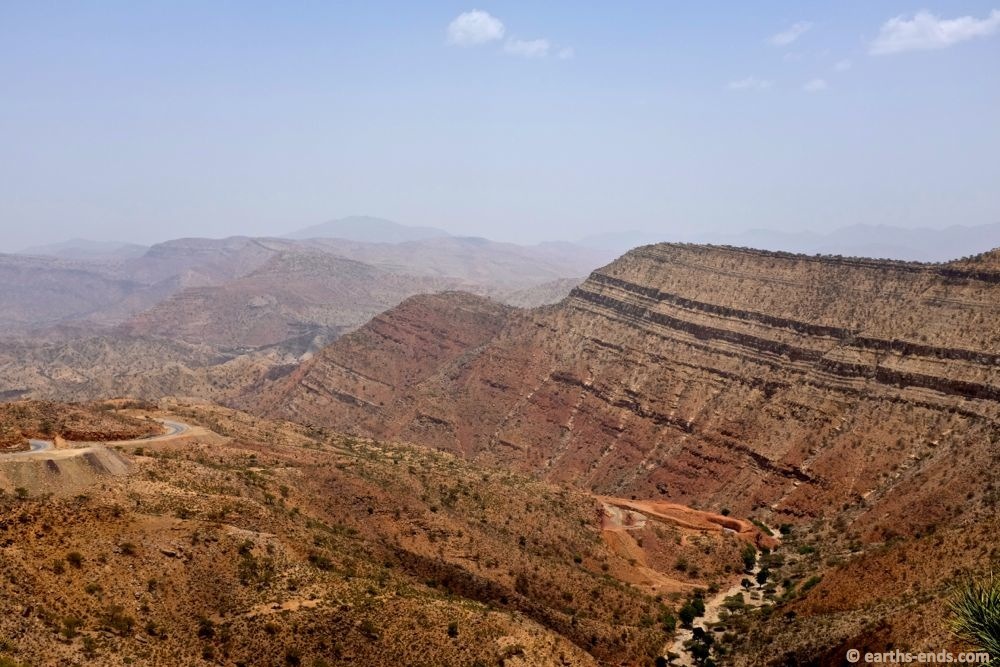
Not far out of Mekele.
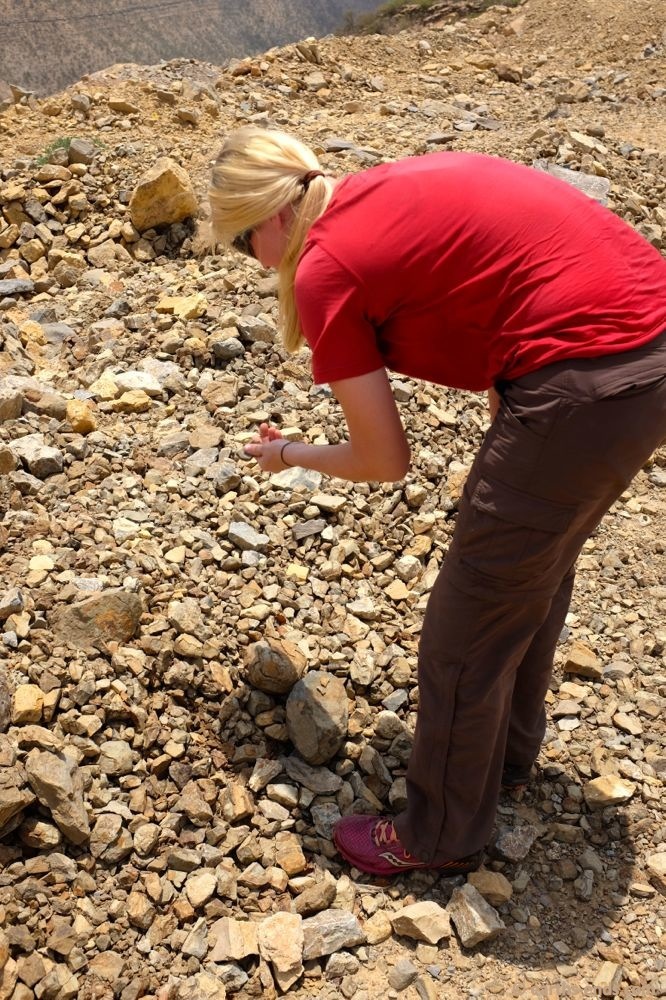
People used to pay me to do this.
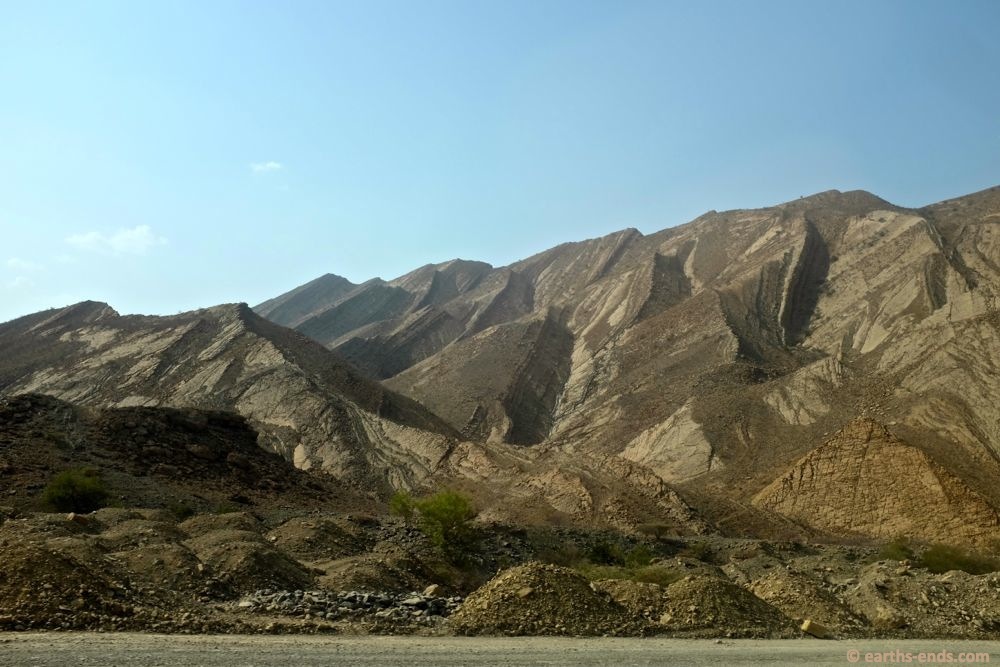
Views that had us pining for Namibia once more
We stopped for lunch in small town of Berhale, which is the centre of the salt trade in the Danakil Depression. Berhale is the traditional drop off point for the salt caravans transporting salt bricks from Danakil’s salt mines prior to transportation (these days by road) to the city of Mekele. Salt mining takes place 10 months of the year with a 2 month break at the height of summer when the conditions are just too punishing on man and beast.
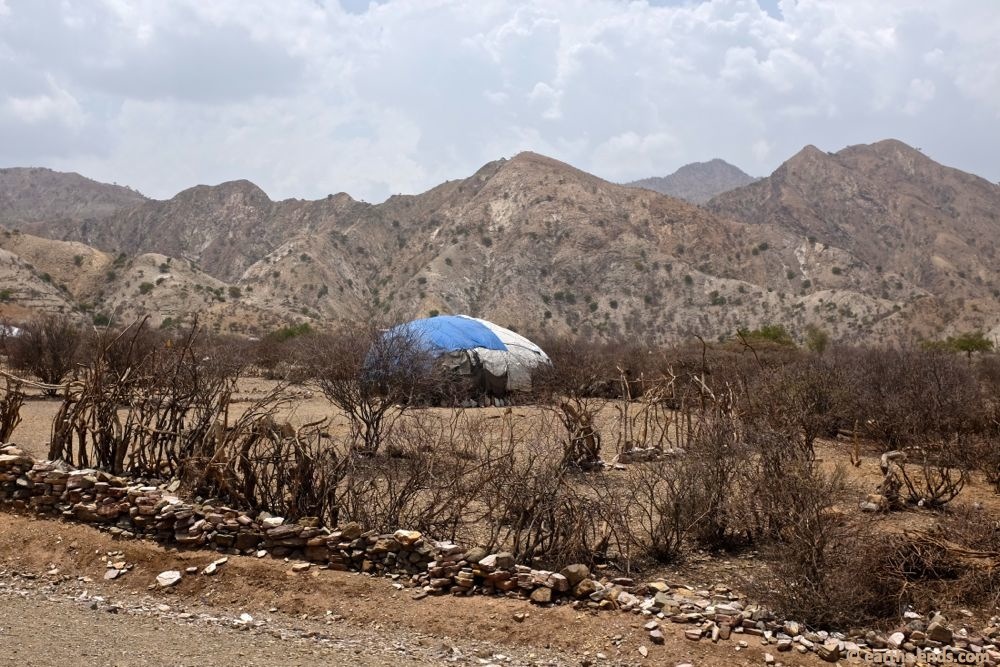
Afar habitations on the way to Berhale.

The camel trains of the Danakil. It is estimated that more than 1 million camels per year do the trek from the mines to Berhale. Wish I took this shot but it was someone else on the internet
It was a shame we missed out on seeing the ‘white gold’ trade in action. In the seemingly pervasive theme of this trip of ours, the modern world is encroaching and is set to overwhelm the traditional way of life in the area. The smooth tar roads we just travelled along will be the nail in the coffin of the millennia old practice of salt mining. With the roads in place, modern commercial salt companies requiring only a modest labour force due to their mechanised extraction techniques will inevitably enter the fray and crush the traditional salt mining trade. If you want to see Danakil, I’d advise doing it sooner rather than later, because when that happens the proud and traditionally armed to the pointy teeth Afar, will likely not take the changes well. The Afar have furiously guarded their salt resources for centuries and will hardly stop now, particularly when there remains no alternative livelihood.

Salt mining. Also some other clever bugger’s photo
After a simple yet tasty lunch followed by ice cold soft drinks we were back in the cars and on the road again, this time on our way to the salt mining hub of Lake Assala.

Apart from the new tar roads (build to service Israeli and Canadian potash mining operations) the towns had very little in the way of amenities.
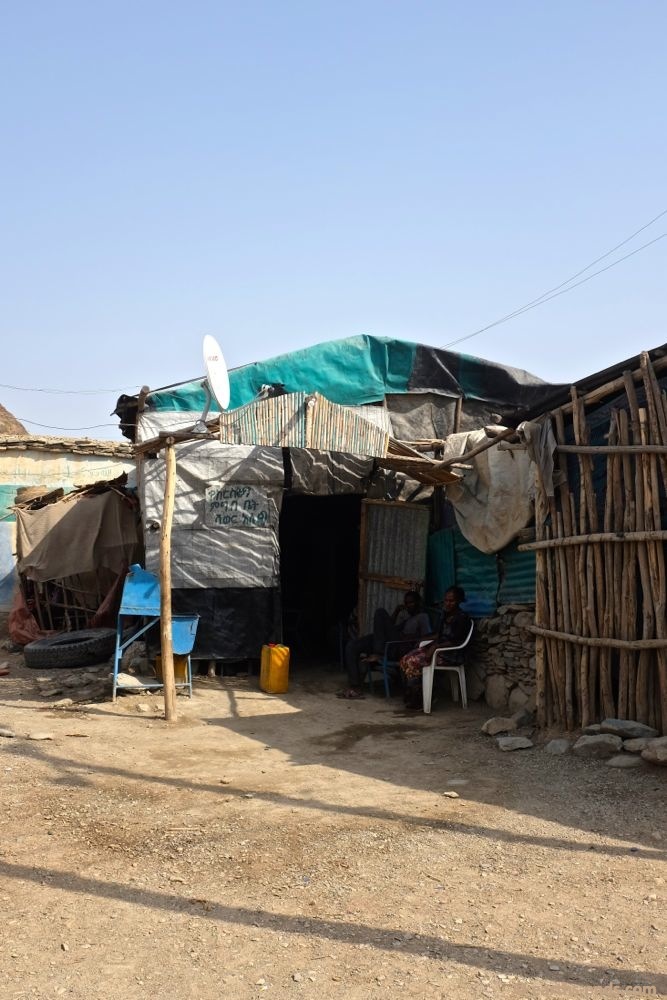
Our restaurant wasn’t much to look at but the food hit the spot.
After picking up a few compulsory military personnel with AK47s to guard us during our next excursion we headed along salt roads to the nearby salt plains. Some areas of the Danakil Basin are said to have between 2.5 and 5km thick salt layers deposited over millions of years while the area was connected to the Red Sea during periodic sea transgressions and flooding events. The estimated date of the most recent sea transgression into the Danakil basin is around 30,000 years ago.
After goofing around on the saltpans for a bit it was back to tiny little hamlet of Hamed Ela for the night. Hamed Ela is a located 92m below sea level and is bit of a miserable sight. It is dry, dusty, rocky and littered with countless water bottles from the steady stream of tourist groups that come through. We found a bucket of non-saline water to bathe in (hard to get around these parts) before having a great dinner despite the Spartan surrounds.
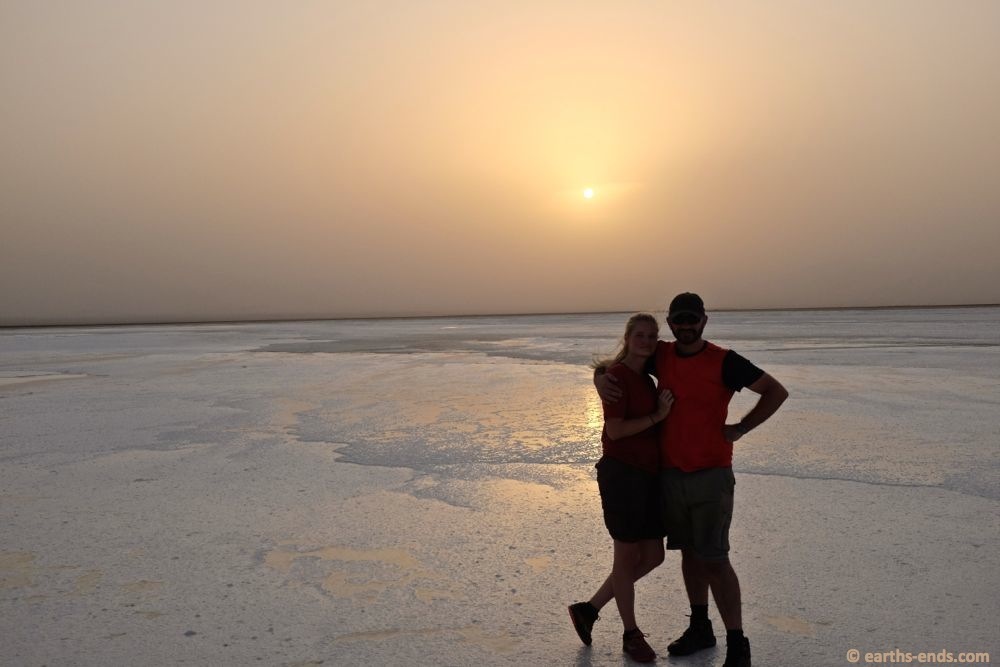
Sunset over the saltpans

Goofing off on the salt pans

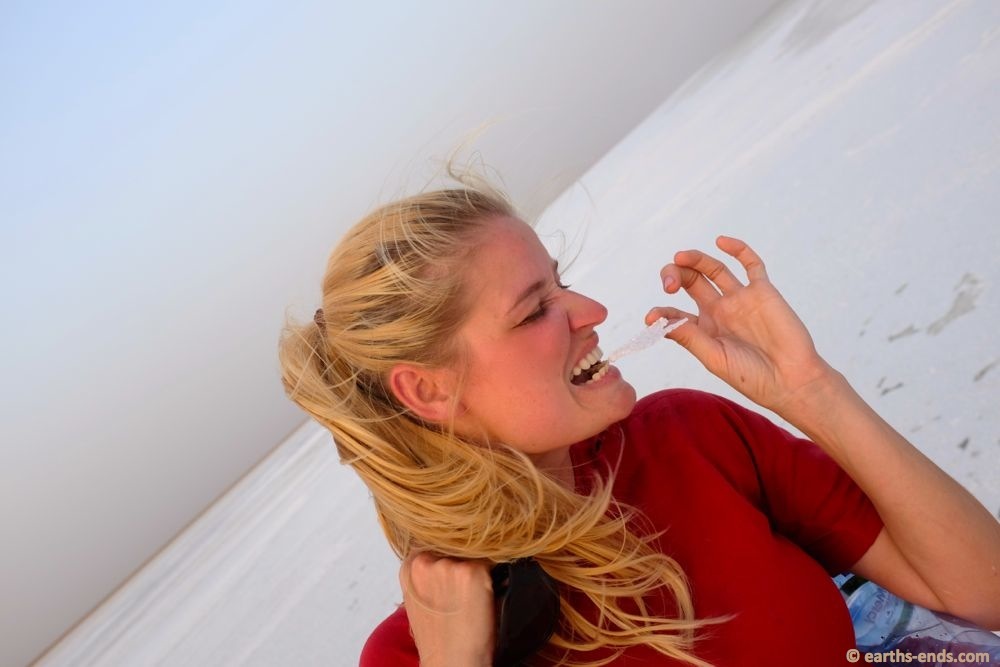

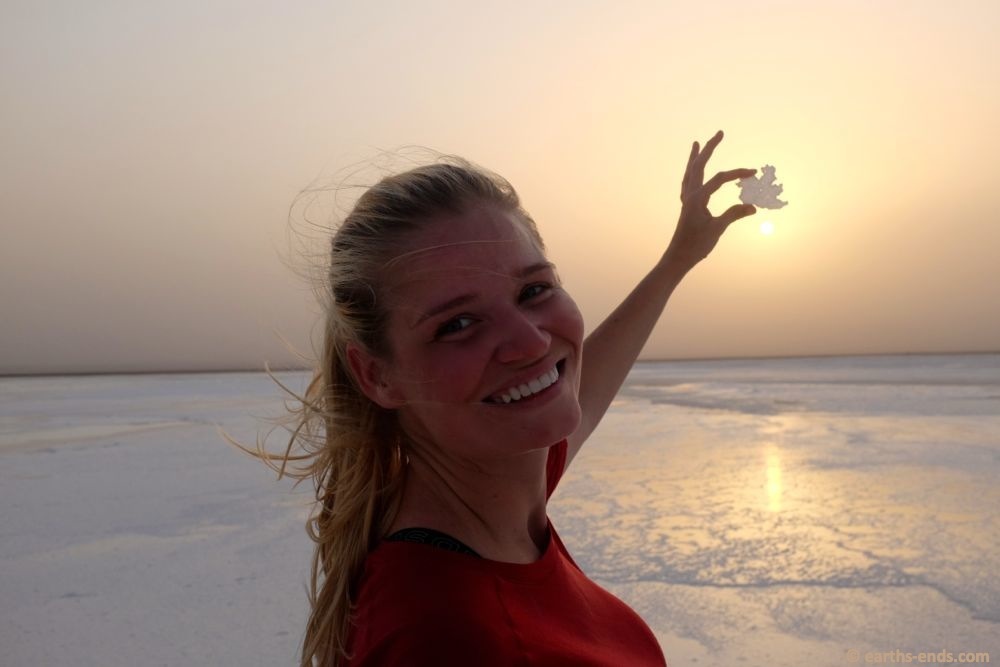
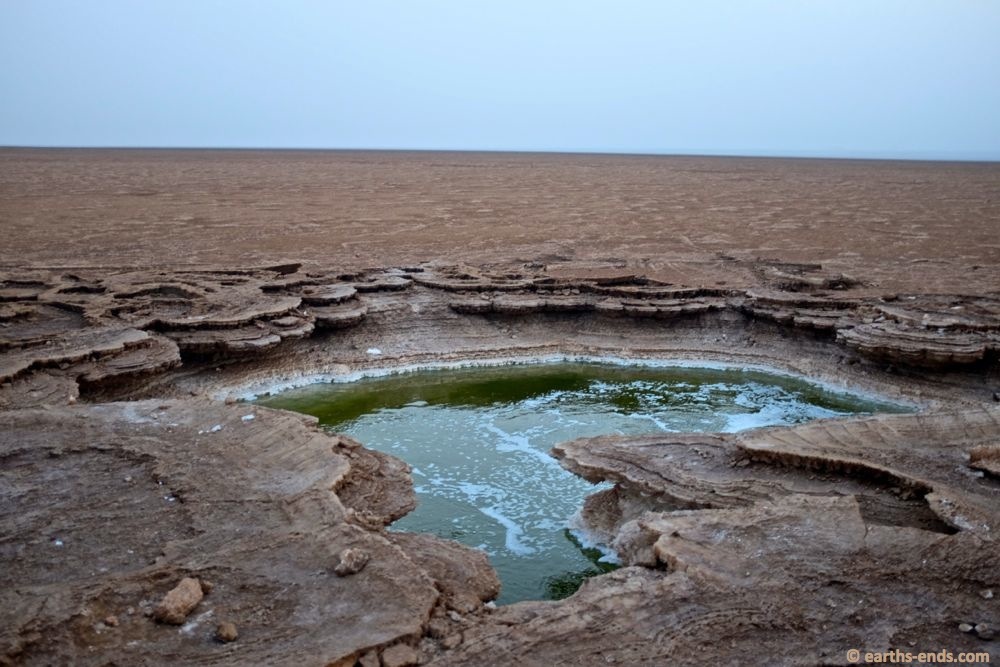
Tours traditionally stop at this place for a dip. These waters are of higher salinity than even the Dead Sea.

A couple of the others got it but we passed.
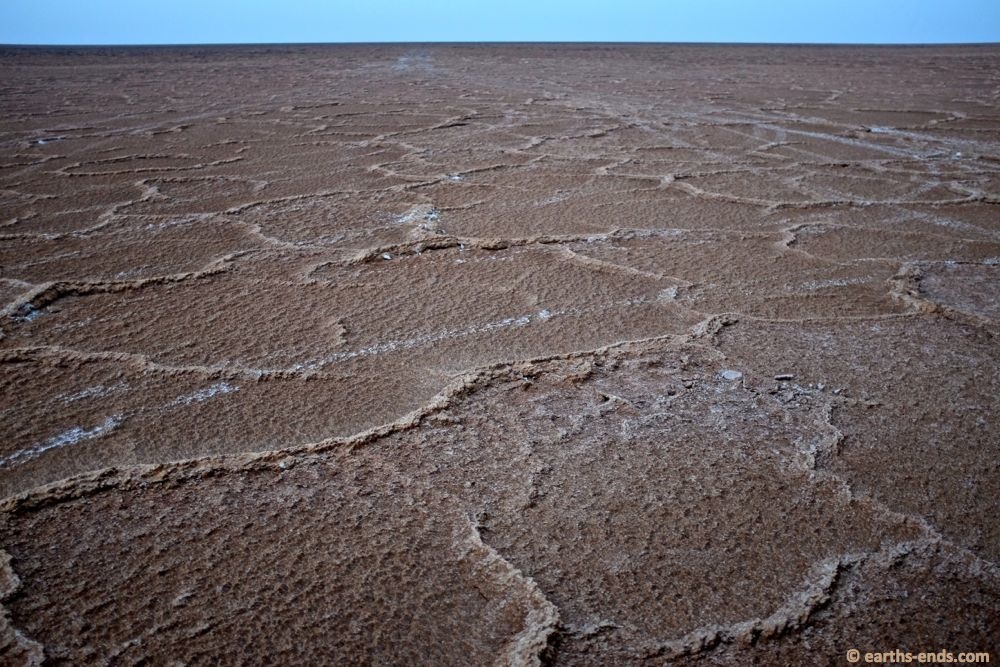
There was plenty of land that looked like this.
Sleep was near impossible to come by that night due to the heat. Mick and I are used to heat and world-class sleepers but our skills were rendered inadequate given the conditions. It was still 40 degrees when we went to bed about 11pm and only dropped to a minimum of 38C in the early morning. We were sleeping on raised cane beds out in the open but there was little respite from the suffocating heat as we tossed and turned and periodically doused ourselves with water. As the Afar people are predominantly Muslim we went to efforts to cover up to the extent that our bodies could tolerate. But all that went out the window that night as one piece of clothing after another was jettisoned until we were all sprawled out in our underwear being culturally inappropriate in public and struggling to care.

Hamed Ela – It is from this ramshackle collection of huts that 5 tourists were kidnapped in 2007 and held for a fortnight. Luckily they were all returned unharmed.
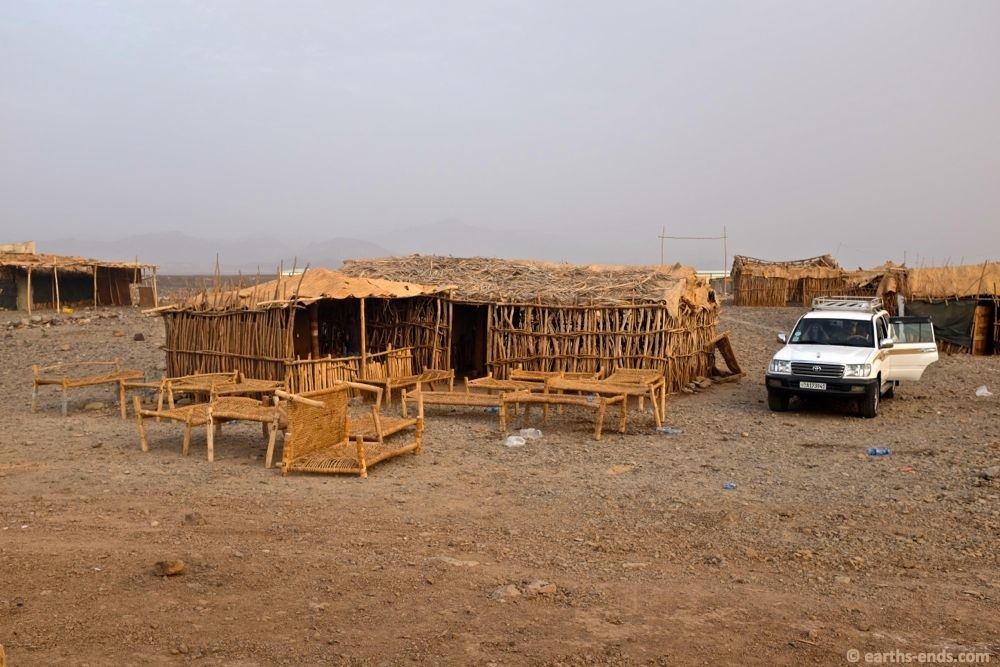
Our lodgings for the night. The bathroom is wherever you make it and a toilet visit required a decent hike to have any semblance of privacy… and even then…
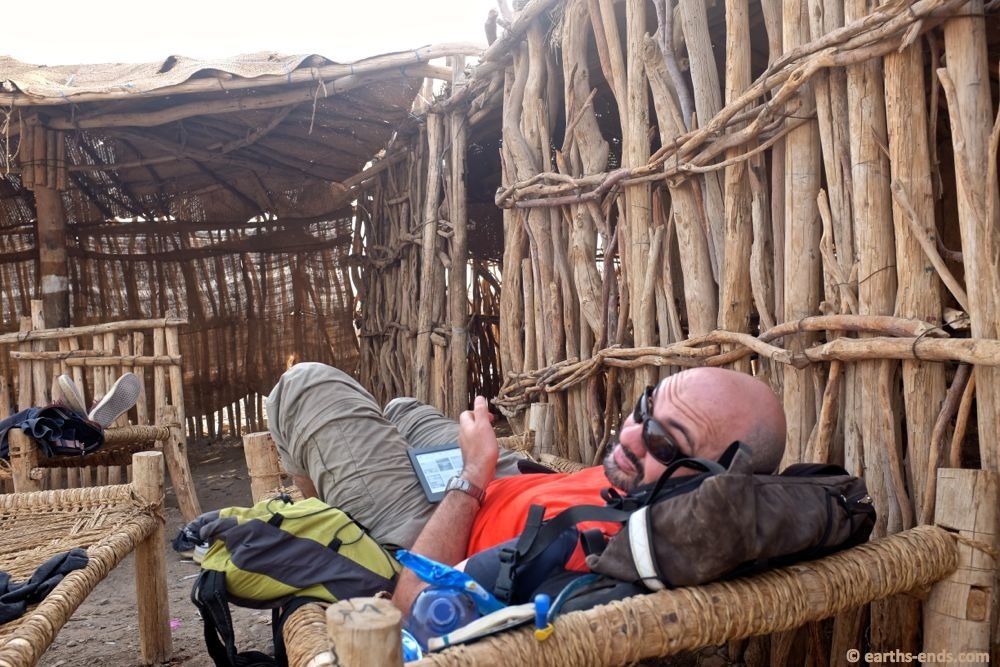
Mick chilling as well as he could in a desert 92m below sea level.

The architecture, though not much to look at, was a great way to get shade and let the air circulate. In the background you can see a building that could only belong to the nearby Potash mining operation.
Fortunately when we woke the next morning there was no one in sight to witness our debauched public sleeping. After a few hours of broken sleep we were up having breakfast in the dark, and on the road before 6am in order to visit Dallol volcano and its psychedelic hot springs. The Dallol area is located 120m below sea level and subsequently experiences ridiculously high daytime temperatures. And there was no question of going to Dallol in the middle of the day. By 7am the temperature was already 48 degrees and would soon rise to over 50.
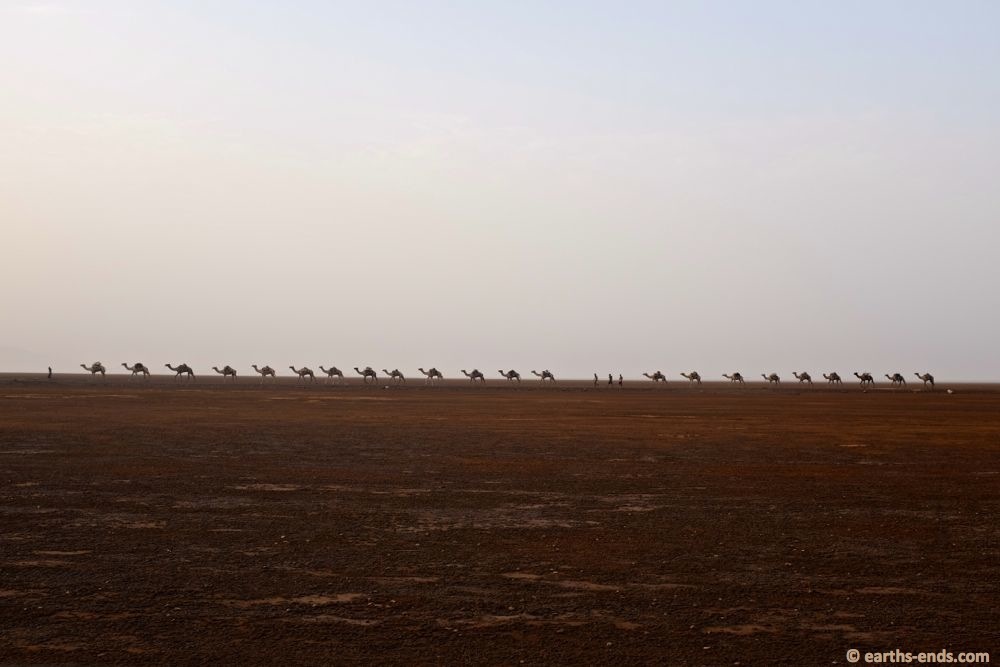
It is only the die-hard salt miners that operate this time of year. We drove past this lone train of camels heading out to the salt mines. I had to wonder what it was that pushed these guys to make the trip when no one else was… when both they and their camels would be utterly punished by the conditions…
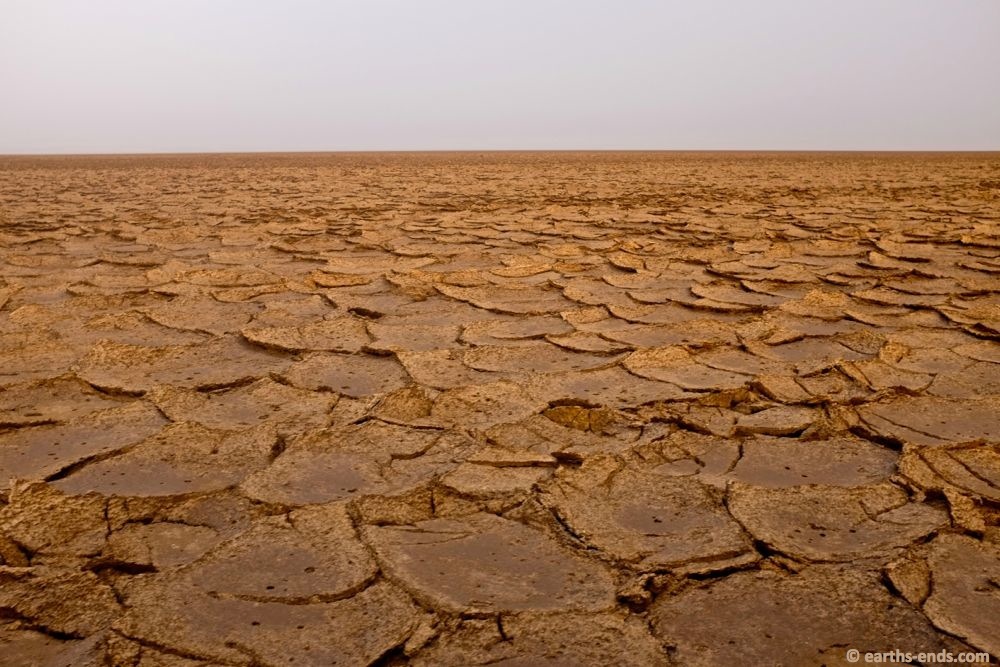
Tepee structures – formed by the dilation of surficial beds or shrinking of underlying sediments, when laterally confined material cannot expand they rear up under compression like this.
The landscape to the volcano consisted of flat saltpans extending off into forever. While travelling along the salt roads we couldn’t help but imagine ourselves on our bikes absolutely fanging it. It was odd and frustrating to find ourselves moving at a snails pace over minor washouts we wouldn’t have bothered to even slow down for on the bikes. The blessed air-conditioned cab on the other hand was a welcome consolation for inferior 4-wheeled mode of travel.

Cars parked at the base of Dallol’s updomed salt structure. You may not be able to tell from the photo but it rises 50-60 m above the salt plains.
An oppressive heat consumed us as soon as we got out of the car. Despite the monotonous landscape the appearance of the Dallol volcano is decidedly subtle. Dallol is a pretty unique type of volcano in that it is not actually a volcanic cone but a dome (anticlinal) that rises from the extensive salt plains at a gentle gradient caused by the intrusion of a magma body that is the heat source for the geothermal system. Gravity and magnetic airborne surveys indicate an anomaly (most likely the igneous intrusion in question) at a depth of around 1km. Geologists aren’t sure of the date of the updoming and formation of the Dallol volcanic system but surmise that it occurred after the last major sea incursion that formed the salt layers some 30,000 years ago. Because after all, you can’t deform sediments before they are deposited – and there you have it! The essence of geology – logic and inference… and lots of guessing… and a bit of the science… but mostly guessing.

Yeah… so this is true
Dallol itself is essentially an explosion crater caused by a huge phreatic eruption. A phreatic eruption is one that occurs when a high temperature heat source contacts and heats groundwater to the point of boiling, resulting in an explosive plume of rocks, ash, water and steam. These types of eruptions are hard to predict in that all it takes is a fissure/crack to open in a system like Dallol through shifting magma below or a minor earthquake (Danakil is very seismically active). It just takes a blast of heat escaping the fissure and groundwater to enter the crack and turn to steam. As steam occupies greater volume than water it expands in all directions and causes a violent explosion of pulverised rock, heat and steam. Back in 2014 there was a phreatic eruption of Mount Ontake in Japan that killed 36 people. Japan’s volcanoes (including Ontake) are rigged up with a mass of sophisticated monitoring equipment and while they can predict the deeper level activity, shallow steam eruptions like the ones that take place at Dallol are basically impossible to predict. So be sure to wear your lucky underwear should you visit.
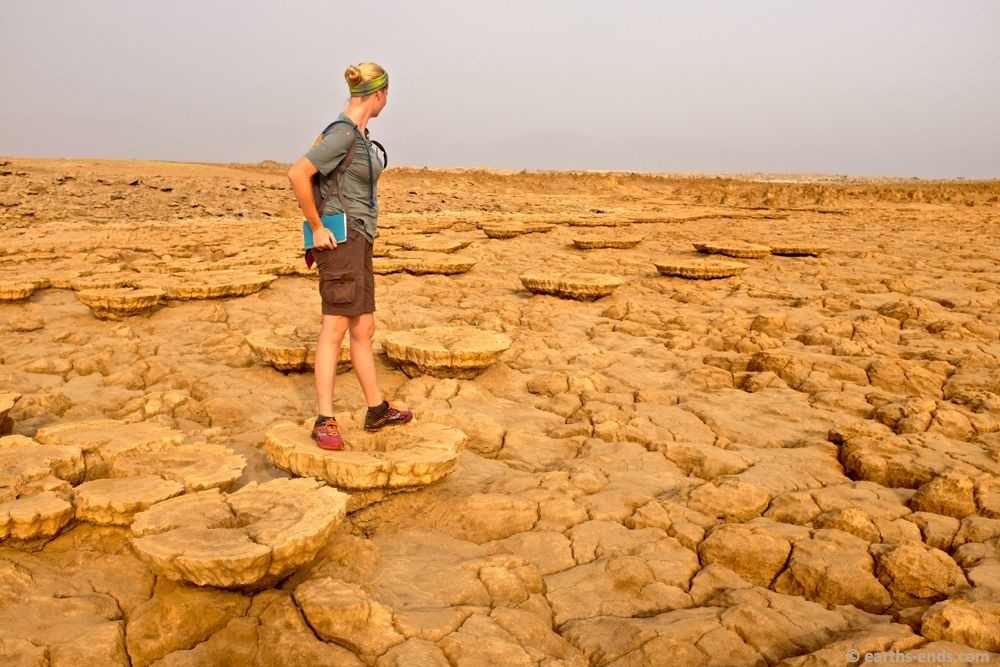
Salt mushroom structure from a no longer active hydrothermal pool. These are named for the obvious resemblance to mushrooms. These bad boys can be as large as half a metre in diameter. They usually form after periods of intense evaporation when the shallow pools become covered with a thin, delicate layer of floating halite crystals. Some crystals sink to the bottom of the pool and accumulate enough to form stalagmites (like a stem of halite crystals going upwards) which reach the surface. At this point, floating halite crystals accrue as concentric rings of halite and adhere to the stalagmitic stem.
The most significant eruption at Dallol occurred in 1926 but there has been some interesting activity in recent history. In January 2011 an ash plume was observed rising from the Dallol crater. Then in very exciting news, on January 2, 2015 (just 6 months before our visit) it is reported that an ash plume and nighttime incandescence was observed above Dallol which would make it the first magmatic eruption (phreato-magmatic eruption is the precise term for a steam blast eruption with extruded magma in the form of volcanic bombs). I didn’t notice any signs of extruded volcanic material and haven’t been able to see that the event got confirmed but if it did in fact happen it would be the first time magmatic activity has occurred at Dallol which is a pretty big deal. Suffice as to stay that the system is still very much active.
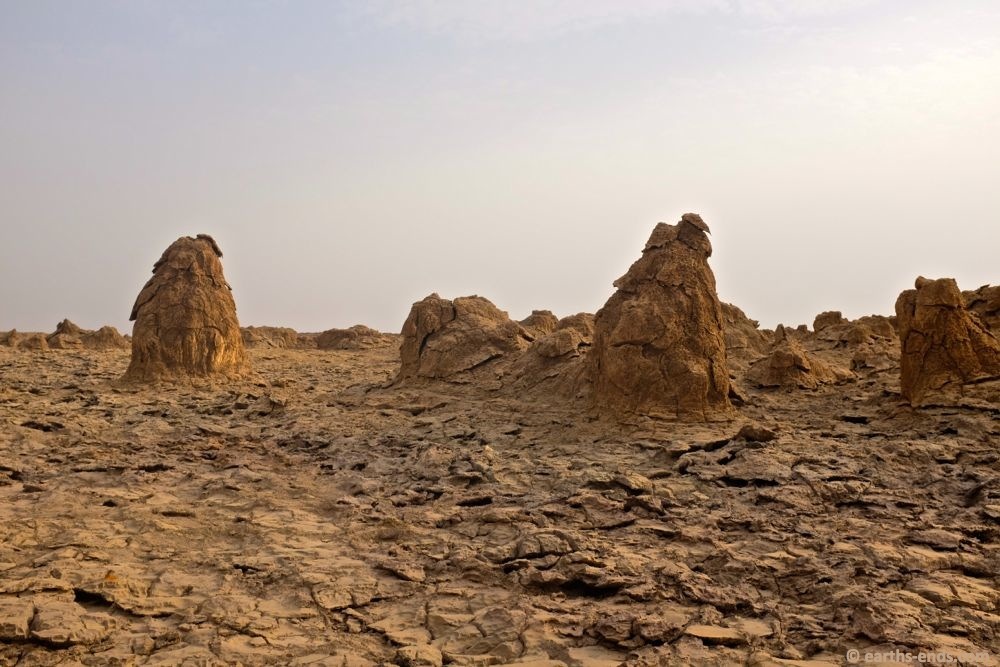
Old salt pillars. Compare this to the active pools and you’ll see how the surface features of the hydrothermal system have moved over time.
But what really makes Dallol worth writing home about is its surface manifestation – the assault on the senses, iridescent wonder of the Dallol hot springs. It has to be one of the most vibrantly colourful natural landscapes on the planet – like looking through a kaleidoscope while on an acid trip. And it all thanks to the relationship between Dallol’s heat source and the thick succession of overlying salt deposits.

Why things are so at Dallol

The colours on display at Dallol are dictated by the height of the water table. Colours change from light (whites and yellows) to darker reddish hues when water level drops and can go on then return to its previous colours when the water table rises again. Here we are in a section above the current water table.

You should therefore avoid walking through any of the white, green yellow areas as much as you can. There is a definite risk of finding yourself ankle deep in highly acidic boiling fluid.
 The lurid colours of the hot springs are due to an orgy of halite, calcite, sulfur hematite, iron, sodalite, fluorine, potassium salts, mud and halophile algae and a whole lot more.
The lurid colours of the hot springs are due to an orgy of halite, calcite, sulfur hematite, iron, sodalite, fluorine, potassium salts, mud and halophile algae and a whole lot more.
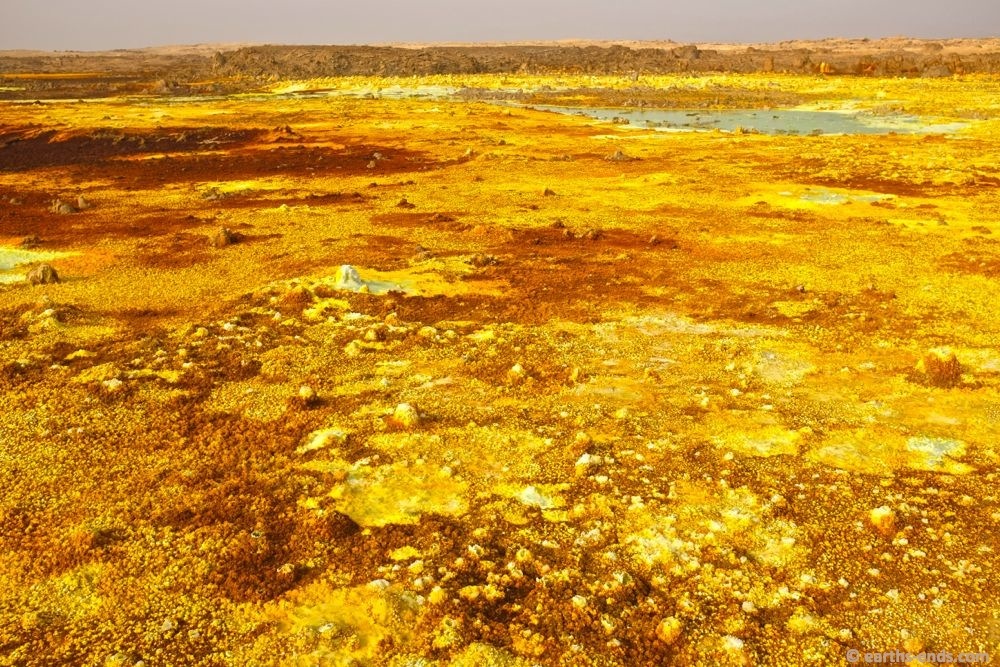
Dallol is an uplift feature topped by a phreatic crater full of hydrothermal karst structures.
 A geologist – out standing in her field (see what I did there?)
A geologist – out standing in her field (see what I did there?)
 Hot as Hades
Hot as Hades
 The pools are very high salinity and range from moderately to extremely acidic. NO TOUCHING!
The pools are very high salinity and range from moderately to extremely acidic. NO TOUCHING!
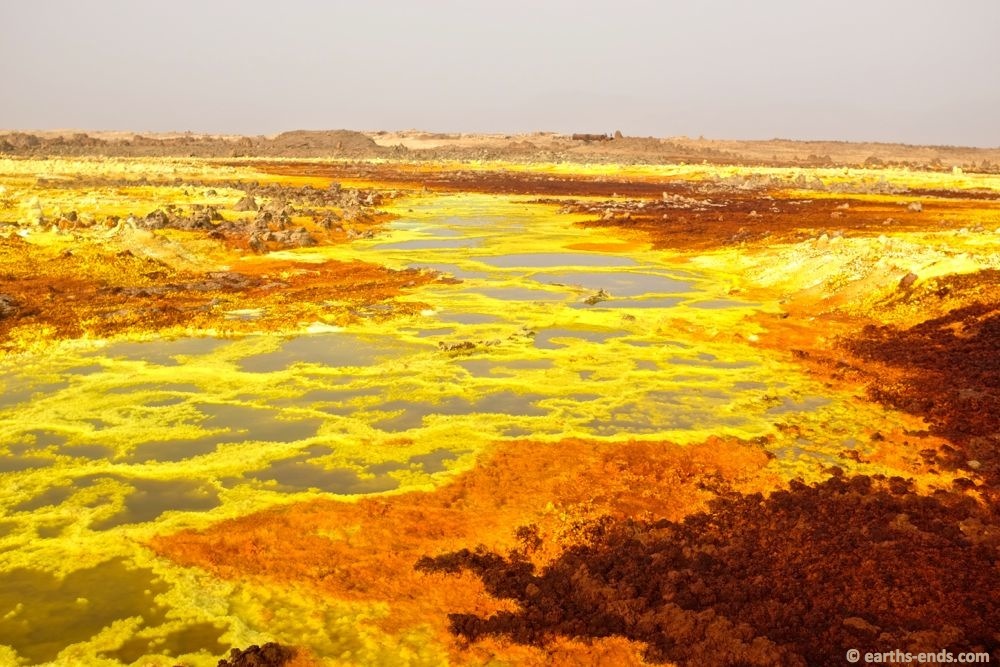
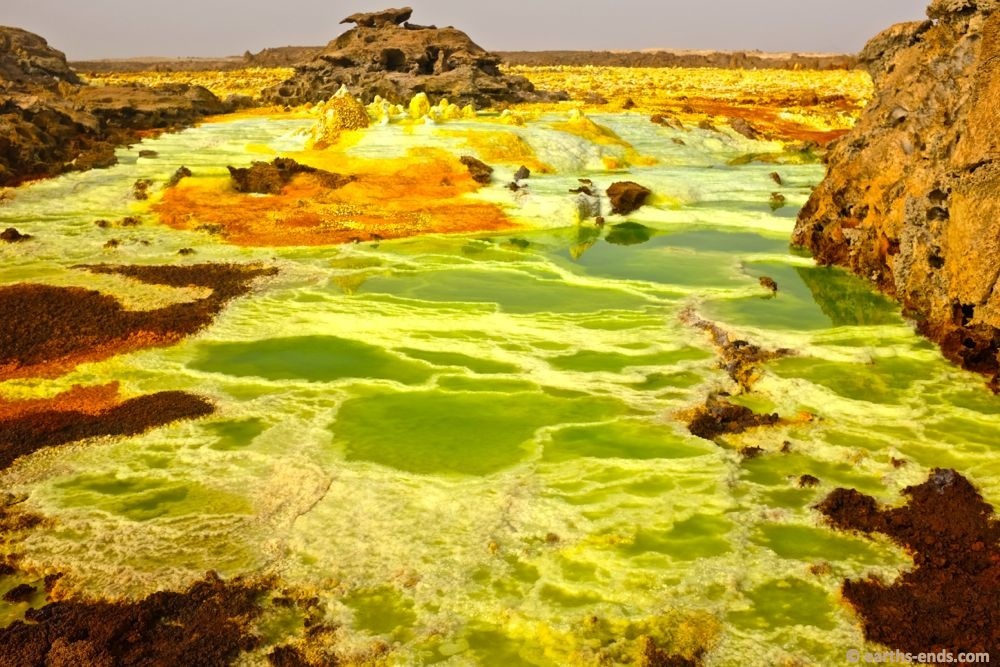 Terraced acid lake with salt deposition.
Terraced acid lake with salt deposition.

Our Afar guide sitting on a domal structure full of gas pipes.
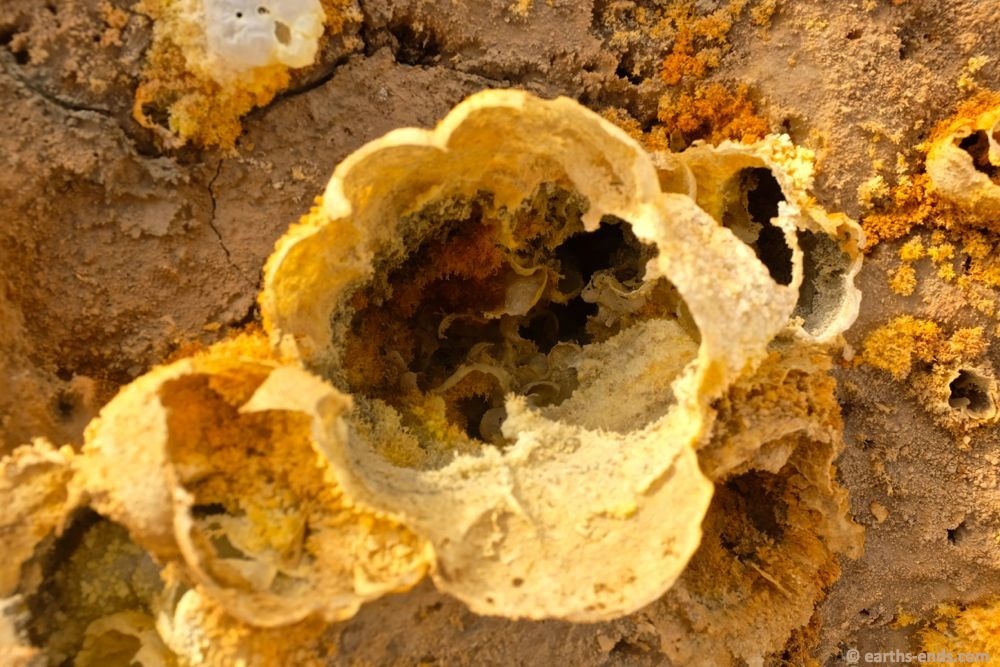
Some of the delicate salt formations you can find in these gas pipes/fumaroles. I’ve read that measurements have been taken of the amount of gas that emanates from these fumeroles and it is said to be negligible….even so I wouldn’t stick your face in there.

Delicate little salt balloons

Salt balloons and salt flowers
The hot springs occur within a subsidence structure of a phreatic eruption crater. The springs are formed by the groundwater heated by Dallol volcano’s magma source rising through the deep successions of evaporite deposits. As it does so the groundwater becomes a supersaturated, supersaline brine incorporating different minerals on its rise to the surface where it eventually emerges through hot springs. As the brine evaporates, salts are precipitated to form a variety of salt formations including salt pillars, salt terraces and geothermal pools.
 Due to the minimal levels of dissolution and erosion in the crater it is estimated the hydrothermal pools are perhaps only hundreds of years old which is embryonic in geological time… 100 million years is positively youthful in rock terms. The underground manifestation of the system is most likely considerably older.
Due to the minimal levels of dissolution and erosion in the crater it is estimated the hydrothermal pools are perhaps only hundreds of years old which is embryonic in geological time… 100 million years is positively youthful in rock terms. The underground manifestation of the system is most likely considerably older.
Dallol isn’t the safest places to spend a lot of time. There are no pathways to follow and the ever-changing environment can leave you walking on a salt crust of unknown thickness over up to 110°C (the water can be saturated with various salts don’t forget), highly acidic fluid (the geo-chemistry is highly complex). There is also the additional hazard of gases to worry about… and eruptions aren’t out of the question – you’d have to be pretty unlucky though. My advice when near the geothermally active areas; wear closed in shoes and watch your step, don’t touch anything wet and/or colourful, and keep your face away from holes or fissures (fumaroles – they can emit hot gases).

Salt pillars form from a small central upflow point where halide precipitates on emergence at the top of the pillar. Pillars are also found in the more intense geothermal activity.

Returning to the cars. We would only spend a couple hours this deep in the depression as the heat formidable
Next we made our way to check out the nearby salt canyons where uplifted layers of salt deposits have been eroded away to form towering pillars of up to 40m tall. We did a hike for as long as we could tolerate the heat. By now we were all red and completely saturated in our own juices as our bodies strained to cool down. It was amazing to see how our non-acclimatised bodies were coping with the conditions compared to the local Afar guide. The tour guides and drivers from the highlands were struggling as much as us, while the local Afar guide, skinny as a rake, didn’t even have a bead of sweat on him. I did notice however that by the time we were done with the hike he had only the beginnings of a sheen of moisture developing on his skin. Makes sense for people living in a place like this – with water so hard to come by, sweating is a luxury they could ill afford.
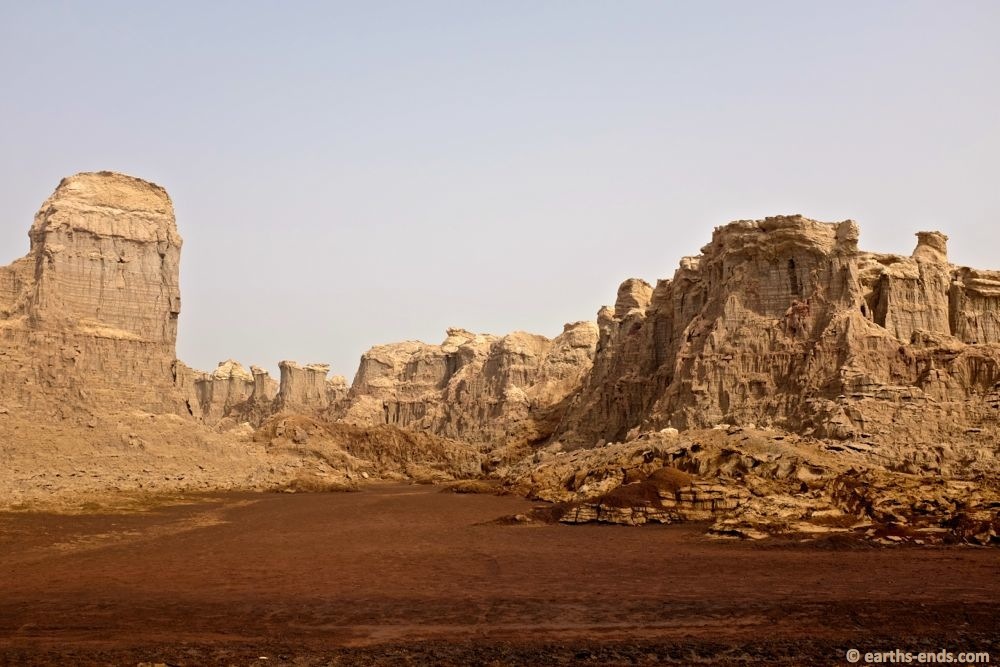
The towers and pinnacles were eroded by wind and seasonal flooding.

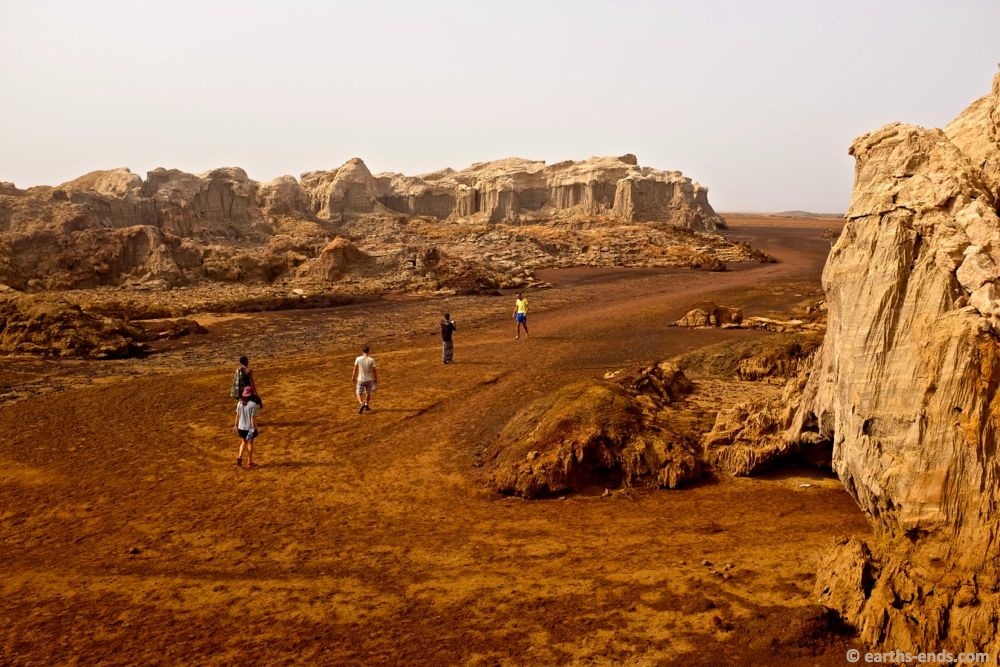

The rocks are composed mostly of salts of potassium and magnesium, interspaced with layers of soil.

The banding is the result of clay and soil deposition from seasonal flooding in the highlands.

Potassium rich brine pools. These are just a mixture of groundwater and geothermal upflow so not boiling and not acidic like at Dallol. Here the military guards are lathering themselves as they thought it was medicinal and good for the skin. Considering the number of dead birds around the pool I’m not sure how they came to this conclusion.

But the military personnel were convinced the water was good for the skin so got lathered up. Incidentally, if you look to the top right of the photo you can see how high the pool levels had been in the past.

Our skinny as a rake Afar guide to Dallol. The dead bird carcasses strewn around the pool seems to conflict somewhat with military guys’ assessment on the water.
After a prudently short time visiting Dallol we hopped back in the car and headed along the near roads to a small village possibly called Abaala. Abaala is traditionally the place where the Danakil tours spend a night in relative comfort in between the two nights spent in discomfort near the Dallol and Etra Ale volcanoes. The night’s accommodation was at a family homestay at a much more tolerable altitude.
The homestay family included a teenage girl who spoke English very well and surprised us greatly when she told us she spoke basically fluent Korean. Not at all something you would expect from a young Muslim girl living in a tiny village in the Danakil Depression. Her impressive skill was borne from her love of Korean soap operas and a lot of commitment and I was more than a little impressed.

The Korean speaking girl in question. It was here dream to make it to Korea to study. Lucky for her a Korean animator met her during a Danakil tour. He is currently making a computer animation short about a young Muslim girl in the Danakil Depression teaching herself Korean from her much loved Korean soap operas. Gotta admit it’s a great premise.
While we were resting inside we noticed the Spaniards had been out playing with neighbourhood children who were extremely grubby. A couple of the kids had conjunctivitis dripping down their faces, a multitude of skin infections and there was a heck of a lot of determined hair scratching going on. The Spaniard’s were busy twirling the kids around, playing hand games and taking selfies. I have no doubt we must have looked like the most anti-social, jaded sad sack travellers by not taking part in the close quarters merriment.

And here she is putting on a coffee ceremony for us.
We pointed out to them some of the highly contagious maladies that they were likely to be sporting themselves if they weren’t careful. They were horrified to learn that conjunctivitis is the result of getting feces or the secretions of pink eye in your eyes. And that ended playtime for the day. They resolutely followed our advice to not touch their faces until they’d washed their arms and hands properly. However it proved to be advice too late in coming for one of the guys, which we’ll get to shortly.
We decided it was time to track down some cold drinks so the Korean speaking girl from the homestay came along and with us so that she could protect us from kids throwing stones. Two of the Spaniards had already been hit by a couple rocks thrown by local riff-raff, and to their credit, were taking it in their stride. Mick was so used to us being moving targets that he knew counter intimidation was required. We had a clean run after he picked up a rock and kept tossing it up and down in his hand the whole way to the bar. Worked like a charm.
After a relaxed evening and a good feed we eagerly crawled into bed. The most exciting and physically taxing part of the tour was yet to come.
 Earths-Ends
Earths-Ends
Recent Comments